

Why a GFCI Keeps Tripping (Solved)
Hubert Miles | Licensed Home Inspector, CMI, CPI
Updated on February 17, 2024
There are several different reasons why a GFCI keeps tripping. The most common reason is water or moisture that has gotten into the receptacle box or outlet. However, a tripping GFCI device could also get caused by an overloaded circuit, a malfunctioning outlet, electrical issues, or improper installation.
According to the National Electric Code (NEC), you must install Ground Fault Circuit Interrupter (GFCI) outlets and breakers in specific locations throughout your home. GFCI protection offers an extra layer of protection to your home’s electrical system. Still, they can be highly inconvenient if they’re constantly tripping and killing power to your outlets.
When a GFCI keeps tripping, it’s inconvenient, but it often happens for a reason. You must get to the root of the cause behind your tripping outlet or breaker, especially if the electrical problems persist. It’s also essential to understand the purpose of GFCI devices and why electricians install them in the first place.
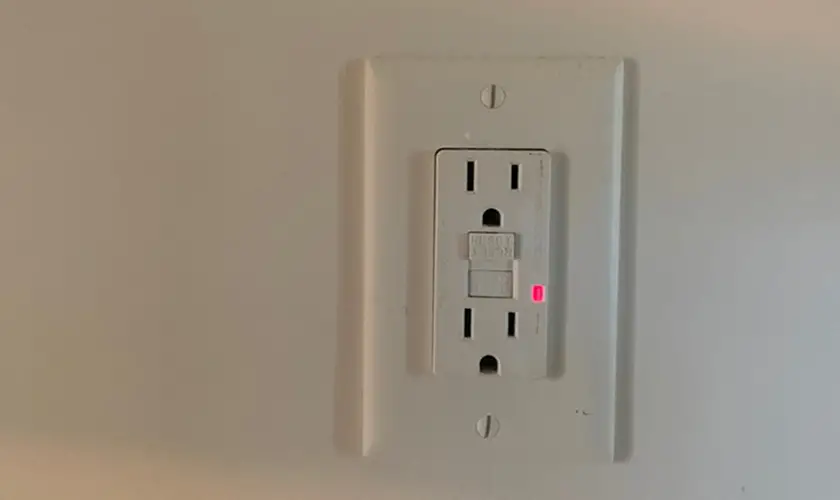
Get FREE estimates from licensed electricians in your area today. Whether you need to replace an outlet, hang a ceiling fan, a new electrical panel, or repair wiring, We Can Help!
What is the Purpose of GFCI?
Ground fault circuit interrupters protect you from a fatal electrical shock around your home. GFCI devices can detect small electrical leaks between hot wires and neutral wires.
A ground fault occurs when the incoming electrical current flow exits on the hot side of the outlet but doesn’t return the same electric current flow to the neutral side. If the current flows aren’t the same, the device will trip and terminate electricity like a breaker.
An electrical leakage current is when the electric current deviates from its intended path. The electric leak will attempt to take the shortest unintended path to the ground, creating an electric shock that can be fatal.
While there’s usually a good reason for a GFCI outlet to trip, it can also happen accidentally. Accidental trips are highly inconvenient and are often the result of improper wiring or installation or a faulty outlet. However, whenever a GFCI outlet is not working , you must get to the bottom of the problem, or it will keep happening.
What Causes GFCI to Trip?
Troubleshooting your GFCI devices is often a process of elimination. There are five main reasons why these outlets and breakers trip, and it’s challenging to put your finger on the right one without an in-depth investigation. To help you get started, let’s go over the five main reasons why GFI outlets trip and what to do about it.
There is Moisture Near the Outlet
The most common reason GFCI outlets trip is because of moisture or water in the outlet or outlet box. Water is hazardous around electricity, so GFCI outlets often get installed in potentially moist areas. These include bathrooms, kitchens, laundry rooms, outdoor areas, and unfinished basements or attics.
A physical splash of water is typically the cause of moisture in an outlet box and is easily detectable. However, in humid areas, such as Florida, it’s also possible for enough humidity to accumulate inside the outlet and cause it to trip.
The best way to prevent this is to install a new GFCI outlet and box with extra protection. Modern GFCI outlet boxes are waterproof and can withstand rain, humidity, and flooding. You should replace your old GFCI outlet with one to prevent further tripping.
Exterior outlets need GFCI protection and a bubble-type weatherproof cover to keep moisture at bay.
An Overloaded Circuit
Another common reason your GFCI will trip is an overloaded electrical circuit. An overloaded circuit happens when you are trying to operate too many appliances or electrical devices on the same circuit. Depending on the size of your electrical wiring, your GFCI circuit can only handle so much power.
An overloaded circuit can short circuit due to faulty or exposed electrical wiring. If two exposed wires are touching one another, it will cause the GFCI breaker or receptacle that’s powering them to trip. Unplug all the devices receiving power from the GFCI circuit breaker or outlet to determine if an overloaded circuit is a problem.
Next, plug everything back in, one device at a time, and see if the problem reoccurs. If it does, an overloaded circuit is likely the cause of your tripping GFCI.
Plugging appliances in one at a time is also an excellent way to determine which appliance is causing the problem. It may be necessary to wire it into a separate circuit or run a new circuit entirely.
A Ground-Fault Occurrence
Ground faults are when the hot wire touches the ground wire or something grounded. Ground faults get caused by several different things, including:
- Worn out insulation
The older your electrical wiring is, the more likely it is to have worn-out wiring insulation. When the insulation wears down enough, the hot wire can contact the ground wire and cause a ground fault.
- Corroded wires
The same is true for corroded or pinched wires.
- Dust or debris
If enough conductive dust collects in the outlet box, it can become an electrical conductor and leak electricity from the hot wire to the ground.
- Loose connections
When either a hot or neutral wire connections are loose, arcing (short circuit) occurs, which will trip the GFCI. The loose wire connection can be anywhere on the branch circuit between the circuit breaker and the GFCI receptacle outlet.
If you can’t visibly see the ground wire touching the hot wire, there’s still possibly enough electricity leakage to cause a tripped GFCI. You should contact a professional electrician or use an electricity leakage tester to see if this is the problem. If the insulation is worn enough, electricity can leak from the hot wire onto the ground.
- Defective appliances
A defective appliance can cause GFCI tripping to occur. A hairdryer can be a defective appliance. Defective electric motors inside common household appliances can cause current leakage, tripping a GFCI.
Nuisance Trips from a Refrigerator or Freezer
When a refrigerator trips a GFCI outlet, this usually means that it is drawing too much power from the circuit, usually when the compressor turns on. To prevent further trips, check if too many appliances are plugged into the same circuit and unplug any unnecessary items.
In older homes, it’s common for the kitchen lights and outlets to share one circuit. Since the refrigerator shares the circuit, the excessive draw can cause the refrigerator trips the GFCI breaker or outlet.
Be sure the outlet your refrigerator is plugged into has a 20-amp rating. If not, consider installing a dedicated 20-amp circuit for the refrigerator.
Many people like to put a spare refrigerator or freezer in their garage . These can often trip GFCIs that the NEC requires inside garages. If your new refrigerator keeps causing GFCI outlet trips, consider plugging it into a different outlet or installing a dedicated circuit.
Your Outlet Has Gone Bad
Like all electrical devices and components, outlets tend to go bad. On average, GFCI outlets last 15 to 20 years, but they can last longer or shorter depending on how your licensed electrician installed them. However, a faulty GFCI outlet will trip for no reason other than that it can’t handle electricity.
It’s good to test your electrical outlets once a month by pushing the TEST button on the outlet’s face. If it trips, the power outlet is working as it should. Press the RESET button once you have finished your test.
Improper Installation
Finally, it’s possible that you or an electrician didn’t install the GFCI outlet correctly. GFCI outlets have to get wired a certain way, and attaching the wrong wire to the wrong spot will cause your device to trip endlessly or not work.
How to fix a GFCI that Keeps Tripping?
When a GFCI outlet keeps tripping, it signals that a problem exists and needs your attention. The only way to permanently fix a GFCI that keeps tripping is to get to the root of the problem.
Nuisance tripping occurs when a GFCI trips for no apparent reason. Getting to the source of the problem of nuisance trips is the only way to ensure that tripping doesn’t reoccur, and you should take this seriously.
Your qualified electrician will likely need to replace the GFCI outlet or breaker and ensure no loose connections exist.
GFCI Keeps Tripping FAQs
When a GFCI keeps tripping, you probably have questions about how to troubleshoot why nuisance GFCI tripping occurs frequently.
Can moisture cause a GFCI to trip?
Moisture is one of the leading causes of a tripping GFCI outlet. Water can result from excess humidity, rain, or flooding.
Will a GFCI trip if it’s overloaded?
A circuit overload is when you try to power too many devices on the same circuit, and it will cause your GFCI to trip as a safety measure.
What causes a GFCI to trip repeatedly?
A GFCI may repeatedly trip if there is an electrical fault, such as a short circuit, or a ground fault, meaning the electricity exits the outlet via an unnatural path. It can also be caused by moisture exposure, worn-out wiring, overloaded circuits, or a bad GFCI sensor.
Final Thoughts
While tripping GFCI outlets is inconvenient, it’s a safety measure. In most cases, a tripping GFCI outlet is good and prevents you from getting electrocuted. These devices rarely trip for no reason, but they can happen. Whether you perform tests yourself or hire an electrician, you must get to why your GFCI is tripping in the first place.
Hubert Miles is a licensed home inspector (RBI# 2556) with more than two decades of experience in inspection and construction. Since 2008, he has been serving South Carolina through his company, Patriot Home Inspections LLC. As a Certified Master Inspector, Hubert is dedicated to providing his expertise in home inspections, repairs, maintenance, and DIY projects.
Continue Reading

Watts to Amps Calculator: DC/AC Wattage to Amps Conversion

70 Amp Wire Size: Breaker & Wiring Gauge Guide

80 Amp Wire Size: Breaker & Wiring Gauge Guide

200 Amp Wire Size: Service Length & Wiring Gauge Guide

10/2 or 10/3 Wire for Mini Split: A Professional Guide

GFI vs GFCI: Understanding the Key Differences

Founded by Hubert Miles, Certified Master Inspector
Home Inspectors
Calculators
Privacy Policy
Terms of Service
©2024 Home Inspection Insider 898 Whispering Pines Rd, Johnsonville, SC 29555 843-250-1882

We Offer 100% Financing | Learn More

- 24/7 Emergency Electrical Services
- EV Charging Station Installation
- Appliance Wiring
- Ceiling Fan Installation & Repair
- Surge Protection
- Electrical Panels
- Outlet & Switch Installation
- Lighting Installation
- Smart Home Automation
- Electrical Service Upgrade
- 24/7 Emergency Plumber
- Bathroom Plumbing
- Kitchen Plumbing
- Water Heaters
- Water Treatment & Filtration
- Lift Station & Pump Services
- Drain Clearing
- Pipe Inspections
- Sewer Line Replacement
- Leak Detection
- AC Installation
- AC Maintenance Plans
- Ductless Mini-Split HVAC
- Indoor Air Quality Services
- Duct Services
- Thermostat Installation
- Special Offers
- About David Gray
- David Gray Comfort Club
- Service Areas
- In the News
- Pay Bill Online
- Call (904) 385-5920

back to blog
5 Reasons Your Ground-Fault Circuit Interrupter Outlets Keeps Tripping
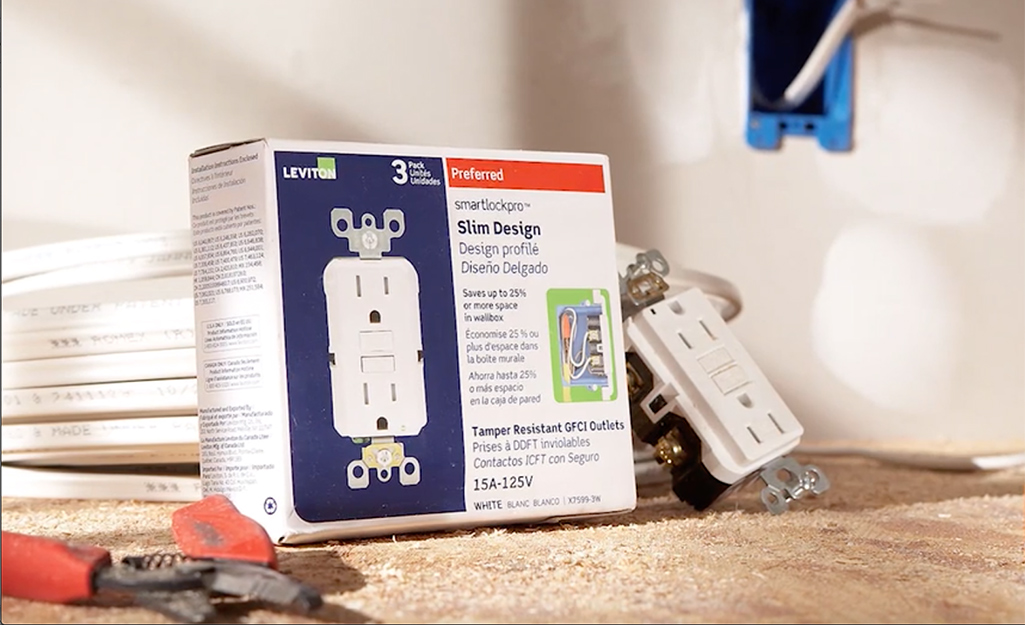
Ground-fault circuit interrupters are designed for your safety. Circuit interrupters, or "trips" as they are commonly referred to, are intended to reduce the risk of fire or electrocution. If they trip, it's an indication there is a problem and you'll need an electrician you can trust.
What Causes Ground-Fault Circuit Interrupter To Trip?
The top five reasons your GFCI outlet keeps tripping are ground-fault occurrences, moisture in the receptacle box, an overloaded circuit, an electrical fault, and a faulty GFCI outlet. We'll cover each of these issues, including causes and solutions.
1. Ground-Fault Occurrence
Ground faults occur when the hot wire or live wire comes into contact with the ground wire or the grounded area of an appliance. Usually, GFCIs function by detecting when the current is flowing along an unintended path (e.g., through water or a person).
The instant the GFCI detects there is even the slightest of current leakage as low as 0.005 amps, it trips right away.
How do you determine if the current is leaking? Unplug everything on that circuit and make sure all the switches are off. Check for any wear that may have occurred to the equipment. Any slight damage means the electrical part is no longer protected from contact.
2. Moisture in the Receptacle Box
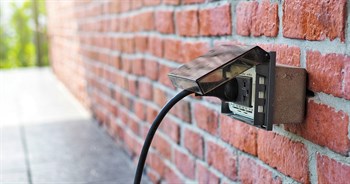
The accumulation of moisture is another major cause of GFCI tripping. Outdoor GFCI outlets are the most vulnerable, and rain is the most common culprit. However, due to the tropical climate of Florida, high humidity can also cause moisture buildup and make it harder for any water trapped in a receptacle box to evaporate.
Start your search by inspecting the receptacle box. Be sure to turn off the breaker before opening the box containing the receptacle. The box must be dry before you attempt to reset the GFCI. It is possible to speed up this drying process using a simple tool such as a blow dryer, but that part is best left to a professional.
If the installation is outdoors or located in high humidity areas, such as the bathroom or kitchen, make sure the box is weatherproof and locked even when the receptor is in use. The presence of moisture can expose you to the risk of accidental electric shock.
3. Overloaded Circuit
Circuit overload occurs when more amperage flows through an electric wire or circuit than it can handle. This may happen if you connect malfunctioning or defective appliances. Loose, corroded wires or connections may also be to blame. Once the GFCI outlet senses an overload, it trips or "breaks" the circuit.
If you want to determine if overloading is really the problem, follow these steps in order.
- Unplug all the appliances connected to the circuit in question
- Reset the circuit on your fuse box
- Wait several minutes
- Plug an appliance back in and turn it on
- Check to see that your circuit has not tripped
- Plug in the next appliance, turn it on, check the breaker, and so on
You may find you'll need to replace the items causing the problem.
If the problem keeps reoccurring, you may need a new dedicated circuit and outlet that can handle the amperage required by the appliances.
4. Electrical Fault
If your GFCI outlet trips consistently, it could be an electric fault resulting from faulty structural wiring. An electrical outlet connected to the same circuit could also be the source of the problem, especially if it was not part of the original wiring of your home. In the case of an electrical fault, you will need a professional electrician to fix the problem.
5. Faulty GFCI Outlet
If you've tried all else and the GFCI outlet reset doesn't solve the problem, that means the outlet itself is defective. GFCI outlets have highly responsive internal circuitry to detect whenever there's a flaw in the electric system. With time, the sensitive circuitry wears out, rendering the outlet dysfunctional. In this case, the outlet will need repairing or even replacing and should be done by a qualified electrician.
Find an Electrician You Trust
David Gray Electrical Services offers a range of commercial and electric services. We have highly trained, licensed, and equipped technicians. If you're experiencing GFCI outlet tripping issues in the Jacksonville area, contact us to schedule an appointment .
Schedule Service
- * Select Service Air Conditioning & Heating Plumbing Electrical Other
- What can we help you with?
- SCHEDULE SERVICE
Serving Florida’s First Coast!
Electrical service: areas we serve.
- Atlantic Beach
- Jacksonville Beach
- Orange Park
- Neptune Beach
- St. Augustine Beach
- The Beaches
Plumbing Service: Areas We Serve
- Beverly Beach
- Flagler Beach
- Painters Hill
HVAC Service: Areas We Serve
Our current specials, free warranty, free surge protector, free air handler.

- Office Locations
6491 Powers Avenue, Jacksonville, FL 32217
15 Hargrove Lane, Unit 6K, Palm Coast, FL 32137
- © 2024 David Gray
- Privacy Policy
The information on this website is for informational purposes only; it is deemed accurate but not guaranteed. It does not constitute professional advice. All information is subject to change at any time without notice. Contact us for complete details.
Request Service
" * " indicates required fields
Your Promotional Selection Has Been Applied!
Common Causes of GFCI Outlets Keeps Tripping and How to Troubleshoot Them

Why Do My GFCI Outlets Keep Tripping?
Common causes of gfci outlets tripping, outlet keeps tripping after reset, outlet keeps tripping with nothing plugged in, outlet keeps tripping when i plug something in, outlet keeps tripping without load, how to troubleshoot gfci outlet tripping.
- Check for Ground Faults: Inspect the vicinity of the outlet for indications of moisture, like water leaks or dampness. Ground faults, which can cause GFCI tripping, can occur due to moisture. It's crucial to promptly address any water-related problems to prevent potential ground faults and ensure the safety of the electrical system.
- Inspect Wiring Connections: To prevent GFCI tripping, it is important to inspect the wiring connections within the outlet box. Check for any loose or damaged wires, as they can cause a GFCI to trip. Safely turn off the power to the outlet and carefully examine the connections, tightening any loose screws or terminals for proper installation and secure connections.
- Test GFCI Outlet Functionality: To ensure the functionality of a GFCI outlet, press the "Test" button to simulate a ground fault and check if it trips correctly. Afterward, press the "Reset" button to restore power. If the GFCI fails to trip during testing or doesn't reset properly, it indicates a potential fault, and the outlet should be replaced to maintain electrical safety.
- Identify Overloading Issues: It's important to be mindful of the current rating of GFCI outlets, usually 15 or 20 amps. If multiple appliances or devices connected to the outlet exceed this rating, it can cause tripping. Evaluate the number of devices connected simultaneously and redistribute the load accordingly to prevent overloading and subsequent GFCI trips.
- Examine Water Exposure: In areas prone to moisture, such as kitchens or bathrooms, it is crucial to protect GFCI outlets with waterproof covers. Water exposure from splashes or high humidity can lead to GFCI tripping. By installing appropriate waterproof covers, you can safeguard the outlet from moisture-related issues and ensure its proper functionality.
- Consult a Professional Electrician: If the above steps do not resolve the problem or if you are uncertain about handling electrical troubleshooting, it is wise to consult a professional electrician. They possess the expertise to conduct a comprehensive assessment of your electrical system and provide appropriate advice or repairs, ensuring safety and reliable operation.
Home Alliance: Your Go-To Electrical Repair Work

Is your laundry taking longer than usual to dry? It might be a sign that your dryer isn't functioning at its best. In this blog, we'll delve into the common rea...
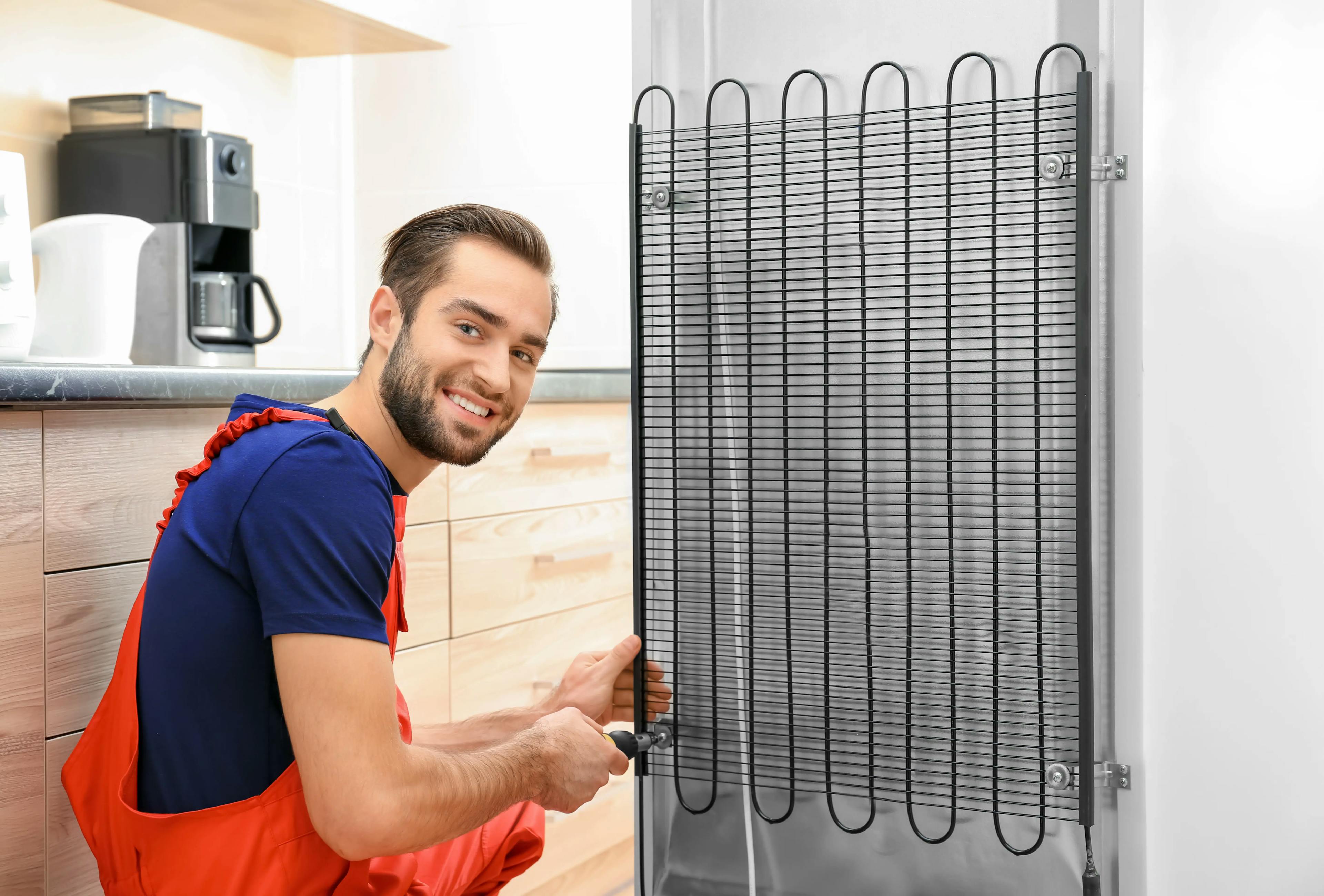
Are you tired of dealing with a fridge that's not keeping your food cold or making strange noises at odd hours? If you've ever found yourself in a sticky situat...

The anticipation of a delicious home-cooked meal quickly fades when you encounter a stubborn oven that simply refuses to turn on. Don't let this setback dampen ...

Why Does My GFCI Keep Tripping with Nothing Plugged In? Common Causes Explained
Have you ever experienced your GFCI (Ground Fault Circuit Interrupter) tripping even when there is nothing plugged in? Sometimes, this can be quite frustrating and confusing especially when you don’t know what’s causing it. But before we dive deeper into why this happens, let’s first understand what GFCI is and how it works. GFCI is a safety device that’s designed to protect you from electrical shock by sensing any leakage of current and quickly interrupting the circuit to prevent electrocution.
It’s typically installed in areas that are prone to moisture such as bathrooms, kitchens, and outdoor outlets. Now, back to the question of why your GFCI keeps tripping when nothing is plugged in. There are several possible reasons for this occurrence.
One reason may be due to a ground fault within the wiring itself. This could be due to damaged wiring, a faulty appliance or a damaged GFCI receptacle. Another reason could be due to environmental factors such as lightning, static electricity or power surges.
It’s important to note that a GFCI that frequently trips may be a sign of a more significant problem and should be addressed immediately. If you’re experiencing this issue, it’s recommended that you seek the assistance of a qualified electrician to locate and fix the problem. Remember, safety is always a top priority when dealing with electrical systems.
What is GFCI and How It Works?
If you’ve ever experienced your GFCI tripping for apparently no reason, you’re not alone. A GFCI, or ground fault circuit interrupter, is a type of electrical outlet that is designed to protect you from electrical shock. It does this by constantly monitoring the flow of current through the circuit.
If it detects a ground fault, which is when electricity flows through an unintended path (like through your body!), it will trip the circuit and cut off the power. Now, you might be scratching your head wondering why your GFCI is tripping when nothing is plugged in. The answer is that GFCIs are incredibly sensitive and can detect even small amounts of current that you might not even be aware of.
It could be something as simple as a tiny water leak in the wall that’s tripping the circuit. So, while it might be frustrating, know that your GFCI is doing its job and keeping you safe.
Understand GFCI Components
GFCI Components GFCI stands for Ground Fault Circuit Interrupter, and it is an essential safety feature in electrical systems. The main function of a GFCI is to protect individuals from electrical shock. It works by constantly monitoring the flow of electricity in a circuit and detecting any imbalances that could result in a shock.
If an imbalance is detected, the GFCI quickly shuts down the electricity to prevent any potential harm. So, how does a GFCI work? The basic components of a GFCI include a current transformer, a differential amplifier, and a relay. The current transformer measures the flow of electricity in the circuit, while the differential amplifier compares the current measurements from both the hot and neutral wires.
If there is any difference between the two, it indicates that some current is “leaking” out of the circuit, which could result in a shock. The relay then shuts off the electricity to prevent any harm. In short, a GFCI is a critical safety feature that helps protect you from electrical shock.
Understanding its components and how it works can help you make informed decisions when it comes to the safety of your electrical systems. So, if you’re not sure whether you need a GFCI or how to install one, it’s always a good idea to consult with a licensed electrician. Keywords: GFCI components, Ground Fault Circuit Interrupter, electrical systems, safety feature, electrical shock, current transformer, differential amplifier, relay, install, licensed electrician.
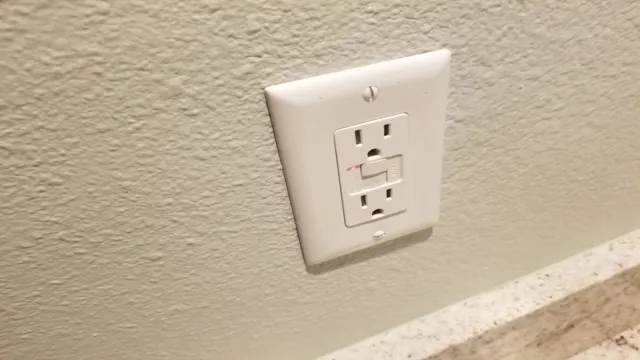
How GFCI Detects and Prevents Electrocution
GFCI, Electrocution GFCI stands for Ground Fault Circuit Interrupter, a device designed to detect and prevent electrocution in homes and businesses. It works by constantly monitoring the flow of electricity, and if it detects a sudden surge or drop in electrical current, it will shut off power to the circuit. This rapid response time is essential for preventing electrical shocks and burns, which can be deadly or cause severe injury.
GFCI outlets are required in many areas of the home, including bathrooms, kitchens, and outdoor areas, where moisture and water can increase the risk of electrocution. They offer a simple and effective way to ensure the safety of individuals and their property from electrical hazards, and they are widely used across the globe. If you are unsure whether you have GFCI protection in your home or business, it is essential to contact a qualified electrician to ensure that you have the level of safety you need.
Don’t take any chances, install GFCI outlets and stay safe!
Why GFCI Keeps Tripping?
If your GFCI keeps tripping, you might be asking yourself why it is happening. The most common reason is that there is a ground fault present in the electrical wiring. This fault can be caused by many things, such as old or damaged wiring, a malfunctioning appliance, or even a sunken wire in the circuit.
Sometimes, the GFCI can trip even when there is nothing plugged in. This usually happens when there is an electrical short due to an old or faulty outlet, switch, or light fixture. It is essential to have an electrician inspect the wiring and appliances to determine the cause of the ground fault.
They can address any issues and replace any damaged components to ensure your electrical system is safe and functioning properly. Remember that GFCI protection is an essential safety measure that helps prevent electrical shocks and fires, so it is crucial to address any issues as soon as possible.
Common Causes of GFCI Tripping
GFCI tripping Have you ever plugged something into an outlet and had the GFCI (Ground Fault Circuit Interrupter) outlet immediately trip? It can be frustrating, but this safety feature is actually protecting you from electrical shocks and fires. There are several common causes of GFCI tripping, including a ground fault, moisture, overloading, or faulty wiring. A ground fault occurs when electricity goes astray and flows through unintended pathways, usually through a person or an appliance.
Moisture can also cause GFCI tripping, as it can create a path for electricity to escape. Overloading the circuit with too many appliances or a faulty wiring can also lead to a GFCI tripping. It’s important to address the issue when a GFCI outlet keeps tripping, as it could potentially save lives.
GFCI Sensitivity and Its Role in Tripping
GFCI Sensitivity GFCI, or Ground Fault Circuit Interrupter, is an essential electrical safety device that protects you from electrocution by detecting and tripping when there is a fault in the current flow. This vital protective device can save your life, but it can be frustrating when it keeps tripping, especially in cases where there is no fault in the wiring. One of the most common reasons why GFCI trips is its sensitivity to current leakage.
The device can detect even a tiny amount of current leakage, as little as five milliamperes, and trip to prevent electrical shock. Factors that contribute to current leakage include old or worn electrical devices, moisture, and faulty wiring. When the GFCI keeps tripping, it is essential to identify the source of the leakage and take the necessary measures to fix it.
In conclusion, GFCI sensitivity is crucial in preventing electrical shock, but it can be irritating when it trips unnecessarily. Regular inspections, maintenance, and upgrades of your electrical system can help prevent GFCI from tripping.
GFCI Age and Wear and Tear Effects on Tripping
GFCI You may be wondering why your GFCI keeps tripping repeatedly. There are several causes for this. First is the age of the GFCI itself: GFCI’s can wear out over time and lose their ability to detect ground faults effectively.
Another cause is the amount of wear and tear the device has experienced. If you frequently use the GFCI, it’s more likely to trip as it becomes more sensitive to faults. Additionally, the electrical wiring in your home might be faulty, causing the GFCI to trip.
It’s also possible that the device is picking up interference from nearby appliances. Without proper troubleshooting, it’s difficult to pinpoint the exact cause of the issue. However, you can try to reset the device to solve the problem, as sometimes a reset is all it takes to get things back to normal.
Don’t hesitate to seek professional electrical services if you’re still having trouble with your GFCI.
How to Fix GFCI Tripping with Nothing Plugged In?
If you’re experiencing GFCI tripping with nothing plugged in, it can be a bit confusing and frustrating. However, there are a few common culprits that could be causing the problem. One possibility is a wiring issue, where loose or damaged wiring is causing the circuit to trip.
Another possibility is water damage, where moisture has gotten into the receptacle and is causing a short circuit. Additionally, it could simply be a faulty GFCI receptacle that needs to be replaced. It’s a good idea to first try resetting the GFCI to see if that solves the issue.
If it continues to trip, it may be time to consult an electrician to diagnose and solve the issue.
Resetting GFCI to Fix Tripping
GFCI tripping, Resetting GFCI If you’re experiencing GFCI tripping without any appliances or devices plugged in, there’s a simple solution that might fix the problem. By resetting the GFCI outlet, you can often eliminate any false trips, and restore power to the outlet. To do so, simply press the “reset” button on the GFCI outlet, which is usually located in the middle of the outlet, between the “test” and “reset” buttons.
If the outlet trips again immediately after resetting, it’s possible that there’s a fault in the wiring that will require the attention of a qualified electrician. However, if the outlet stays on after resetting, you should be able to use the outlet without any further issues. Remember, GFCI outlets are designed to protect you and your family from electrical shock, so if there’s any doubt about the safety of an outlet, be sure to have it inspected by a professional.
Inspecting GFCI Components for Damage or Wear and Tear
If you’re experiencing GFCI tripping without anything plugged in, it may be due to damage or wear and tear on the GFCI components. One way to fix this issue is to inspect the GFCI components for any signs of damage or wear and tear. This can include checking the wiring connections, examining the GFCI outlet for cracks or other damage, and looking for corrosion or rust on the metal components.
If you notice any damage or wear and tear, it’s important to replace the GFCI outlet or have it repaired by a professional electrician. Additionally, it’s essential to ensure that all electrical appliances are in good working condition and to avoid using any appliances that may be faulty or damaged. By taking these steps, you can fix GFCI tripping and ensure the safety of your home and family.
Final Thoughts on GFCI Tripping with Nothing Plugged In
If your GFCI keeps tripping with nothing plugged in, there could be a few potential reasons why. Firstly, it might not be related to anything in your home at all – it could be a problem with the power grid itself, or a nearby electrical storm. In this case, you may need to contact your electricity supplier for more information.
However, if the issue persists, it may be due to a wiring problem in your home. Faulty wiring, especially in older homes, can cause GFCIs to trip even when nothing is plugged in. It’s also possible that the GFCI itself is malfunctioning and needs to be replaced.
Whatever the reason, it’s essential to get to the root of the issue to ensure your home is safe and secure. If you’re unsure about what’s causing the problem, it’s best to contact a professional electrician for assistance. By pinpointing the issue, you can keep your home and family safe while ensuring your electrical system operates smoothly and efficiently.
So, don’t hesitate to investigate the issue and get to the bottom of it – it could save you a lot of trouble in the long run.
Well, it seems like your GFCI has developed a case of hyper-vigilance – constantly on the lookout for any potential electrical hazards. While it may be frustrating to have it trip when nothing is even plugged in, it’s better to err on the side of caution and ensure the safety of you and your home. Perhaps it’s time to do a thorough inspection of all your electrical appliances and outlets to make sure everything is in tip-top shape.
And who knows, maybe your GFCI is just trying to remind you to unplug the toaster before you try to fish out that stubborn piece of toast. Safety first, always!”
Related Posts:
- How Long After Staining Can You Polyurethane: The Ultimate Guide for Perfect Finish
- How Many Times Can You Drill into a Stud? The Ultimate Guide for DIY Enthusiasts.
- How Long Can I Leave Paint in Airless Sprayer Without Drying Out?
- How Long After Staining Wood Can You Apply Polyurethane: A Comprehensive Guide
- How Long After Staining Can You Seal: Expert Tips and Tricks
What are some reasons that could be causing my GFCI to keep tripping even if nothing is plugged in? There might be a fault in the GFCI outlet, or there could be a leakage in the electrical system, or other appliances on the same circuit may be causing the issue.
Can a GFCI outlet trip for no reason even if nothing is plugged in? Yes, if there is a fault in the outlet or leakage in the electrical system.
How can I troubleshoot the issue of my GFCI tripping with nothing plugged in? You can unplug all appliances on the same circuit, reset the GFCI outlet and check if it still trips. If it does, call a qualified electrician to fix the problem.
Is it safe to use a GFCI outlet that keeps tripping with nothing plugged in? No, it is not safe, and there might be an underlying issue that needs to be fixed.
What are the consequences of ignoring a GFCI outlet that keeps tripping? You risk electrical shock or even electrocution, which can be fatal.
Can a GFCI outlet trip due to a power surge even if nothing is plugged in? Yes, power surges can cause GFCI outlets to trip even when there are no appliances plugged in.
How often should I check my GFCI outlets for tripping? It is recommended to check your GFCI outlets monthly to ensure that they are functioning properly.


No More Tripping: Tips for Troubleshooting GFCI Outlets
Ground Fault Circuit Interrupter (GFCI) outlets are a crucial safety feature in modern homes, protecting people from electrical shocks and electrocution.
However, you may encounter a situation where a GFCI trips for no apparent reason. It can be frustrating, especially if it occurs frequently.
In this article, we’ll explore why a GFCI may trip for no apparent reason and provide tips on how to troubleshoot and resolve the issue.
Table of Contents
What is a GFCI and How Does it Work?
Before we dive into why a GFCI may trip, it’s essential to understand what it is and how it works. A GFCI is an electrical safety device that monitors the flow of electricity in a circuit.
It protects people from electrical shock by immediately cutting off power to the circuit when it detects an imbalance in the electrical current, also known as a ground fault.
The GFCI measures the amount of current flowing out of the hot wire and compares it to the amount flowing back on the neutral wire.
If there is an imbalance of more than 5 milliamps, it trips and shuts off power to the circuit.
For more information about the difference between GFCI and CB read my article here.
Why Does a GFCI Trip for No Apparent Reason?
There are several reasons why a GFCI may trip for no apparent reason, including:
- Overloading : GFCI outlets are designed to handle a certain amount of current. If you plug in too many devices or appliances, it can overload the circuit and cause the GFCI to trip.
- Moisture : GFCI outlets are commonly found in areas of the home that are prone to moisture, such as bathrooms, kitchens, and outdoor areas. If water or moisture gets into the outlet, it can cause the GFCI to trip.
- Faulty Wiring: Faulty wiring can cause a GFCI to trip. Wiring issues can include loose connections, damaged wires, or faulty installation.
- Ground Faults: A ground fault is when the electrical current flows through an unintended path, such as through a person’s body. This can happen if a person touches a live wire or a faulty appliance. The GFCI will trip to prevent electrocution.
- Aging: Like any electrical component, GFCI outlets can wear out over time. If your GFCI outlet is old, it may be more likely to trip for no apparent reason.
Read my comprehensive article Why my circ uit breaker keeps tripping , for in-depth information.
How to Troubleshoot a GFCI That Keeps Tripping
If your GFCI outlet keeps tripping for no apparent reason, here are some steps you can take to troubleshoot the problem:
- Unplug all devices from the GFCI outlet: If the GFCI outlet stops tripping when you unplug everything from it, the problem may be an overload of the circuit.
- Dry out the outlet: If the GFCI outlet is located in a moist area, such as a bathroom or kitchen, make sure it is dry. You can use a hairdryer or fan to dry out the outlet.
- Check for loose connections: Make sure all wires are properly connected to the GFCI outlet. Loose connections can cause the outlet to trip.
- Test the GFCI outlet: You can test the GFCI outlet by pressing the “test” button. If the outlet does not trip when you press the test button, it may be working correctly. However, it’s still a good idea to replace it if it’s old or has been tripping frequently.
- Call an Electrician: If you’ve tried all the above steps and the GFCI outlet keeps tripping , it’s time to call an electrician. A professional can help you diagnose and repair any wiring or installation issues that may be causing the GFCI to trip.
Preventing GFCI Trips
While there are various reasons why a GFCI may trip for no apparent reason, there are some preventative measures you can take to reduce the chances of it happening:
- Do not overload the circuit : Avoid plugging too many devices into a single outlet or circuit. Spread out the load to other outlets in the room.
- Keep GFCI outlets dry: Moisture is a common cause of GFCI trips. Keep GFCI outlets dry, especially in areas such as bathrooms, kitchens, and outdoor areas.
- Regularly check wiring connections: Check for loose or damaged wiring and repair them promptly.
- Test GFCI outlets regularly: Test GFCI outlets regularly using the “test” button to ensure they are working correctly.
Here’s a table summarizing the reasons why a GFCI outlet might trip and some preventative measures you can take to avoid those issues:
By following these preventative measures, you can reduce the chances of your GFCI outlet tripping and keep your home safe.
- GFCI outlets are an essential safety feature in modern homes, but they can trip for no apparent reason.
- Overloading, moisture, faulty wiring, ground faults, and aging can cause a GFCI to trip. If your GFCI outlet keeps tripping, there are several troubleshooting steps you can take, including unplugging devices, drying the outlet, checking for loose connections, and testing the GFCI outlet.
- If the problem persists, it’s time to call an electrician. By taking preventative measures such as avoiding overloading circuits, keeping GFCI outlets dry, regularly checking wiring connections, and testing GFCI outlets, you can reduce the chances of GFCI trips and ensure the safety of your home and loved ones.
Install my Free Android App on Google Play :
Electrical Cables Most Common Tables “Electrical Cables Tables”
And, my Electrical Calculations App “ Fast Electrical Calculator ”
Discover more great content by subscribing to My channel
Looking to stay ahead of the game in the world of electrical engineering? Subscribe to my YouTube channel and gain access to exclusive content you won’t find anywhere else!
The staff I recommend
(Amazon Affiliate Links to products I believe are high quality):
- Economy 120 Volt/60Hz AC Power Source – Step-Down Voltage & Frequency Converters 1800W
- UNI-T Digital Multimeter Tester UT139C
- 50-Amp Extension Cord for RV “100ft”
- Voltage Stabilizer 110/220v
- Hair Dryer “best selling “
- TOSHIBA EM131A5C-BS Countertop Microwave Ovens
Disclaimer : This contains affiliate links to Amazon products. I may earn a commission for purchases made through these links.
You Might Also Like
Stay safe and connected: why grounding your panel is critical, prevent electrical fires with gfcis: here’s how they work.

Fuses (for Beginners), AC fuse in DC circuits
When breakers go bad: the top symptoms and solutions.
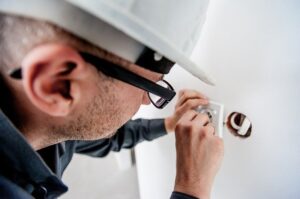
Breaker Keeps Tripping: Understanding the Common Causes and Solutions


8 Reasons Your GFCI Outlet Keeps Tripping Without Load
GFCI outlets are common nowadays because they save us from dangerous short circuits and electrocution. They trip on their own whenever they detect an issue. But what could be the reason behind GFCI tripping without load? Let’s figure it out.
GFCI outlets may trip without load due to current leakage, damaged insulation and input wires, defective outlet, short circuit, and excessive moisture. Reducing the load and checking the wire insulation is the first step to start. Try to pinpoint the problem and take steps to fix the same.
Ground faults and faulty appliances are also responsible. But, it is seen when you plug in any appliance. Stick to this article till the end to explore the reasons behind a GFCI tripping without load and how you can fix it.

Check out our list of top-handpicked products for all your electrical, appliance, and HVAC system needs to keep your home running smoothly.
Table of Contents
What is a GFCI outlet?
The term GFCI means Ground Fault Circuit Interrupter.
This outlet is slightly different from the regular outlets.
GFCI trips if it senses problems like overloading, faulty wirings, or short circuits.
It comes with the test and reset buttons used to test the outlet and reset it when tripped.
These buttons are absent in the regular outlets.
Besides, GFCIs are slightly bigger than regular outlets.
Other than these, there are no other differences.
GFCI outlets are mostly used in kitchens, bathrooms, laundry rooms, and garages.
These are the areas with the risk of moisture and overloading.
Let’s examine some reasons behind GFCI outlet tripping without load.
Why is my GFCI tripping without load?
There are various reasons behind GFCI tripping without any load.
If you find the problem without plugging in, then the following conditions could be responsible for your GFCI outlet tripping:
1. Current leakage
The outlet may trip without load due to the current leakage from the wires.
The currents may leak due to the damaged, old, and worn-out input wires.
The wire’s insulation also might be damaged or worn out, causing the current to leak and make the outlet trip without any load.
2. Damaged wires
The damage in the wires can be anywhere besides the input wire.
Pests or insects might have entered and chewed the wires inside, for which the wires have got badly damaged.
Even with no or low loads, the outlet will keep tripping.
3. A loose wire in the outlet
Wiring issues are a real problem in electrical matters.
If your GFCI outlets trip without load, the wirings might be a problem.
The wires have become loose anyhow.
If you do not fix the wires, the outlet will trip without appliances plugged in.
4. Moisture in the outlet
Another major cause behind GFCI tripping without load is moisture.
Somehow, moisture makes its way into the outlet and begins to accumulate inside the outlet.
Outdoor installations and rains are the most common culprits in moisture getting into the outlets.
Another reason is high humidity.
Areas like Florida have very high humidity, resulting in moisture build-up inside the outlet and making it harder to evaporate.
If you suspect such a thing, turn off the circuit breaker and open the outlet box to confirm the problem.
While resetting the outlet, make sure the outlet is dry.
Otherwise, it will trip again, with or without load.
If the outlets are outdoors or near wet and humid areas like kitchens and bathrooms, ensure the box is weatherproof and locked well.
Exposure to moisture can also lead to short circuits.
You can also use a moistureproof GFCI like this one.
5. Faulty GFCI outlet
If there is no problem but still the outlet trips despite having no loads, the problem could be in the outlet.
Maybe the outlet is defective.
The GFCI outlets have a highly responsive internal circuit system that detects maximum electrical flaws and keeps tripping even if there is no load.
You will have to repair or replace the outlet. Call a professional instead to get the job done.
6. Electricity fault
GFCI outlet constantly tripping without any load might be due to electrical faults, like faulty structural wirings, outlet connected to the faulty circuit breaker, etc.
Here also, you will require a professional.
7. Ground fault
A ground fault occurs when a hot wire comes in contact with the ground wire.
The ground wire is not supposed to have any current.
But, if you connect it to the hot wire, it becomes life, and the current starts flowing.
As a result, the wire fails to save you from short circuits.
It starts carrying more current than the circuit.
Ground faults can electrocute people or buildings without GFCI.
But, if you have GFCIs, it will trip off without delay, despite having no load.
You should consult an electrician if the outlet trips due to a ground fault.
8. Defective appliance
Even if there is no load in the GFCI outlet, an outlet downstream connected to a defective appliance can trip the GFCI.
Connecting a defective appliance to the GFCI outlet will make noises like humming or buzzing.
Repeated appliance use will slowly deprive the outlet in the chain of power.
Ultimately, the GFCI outlet will trip.
If one outlet gets affected, all the outlets (even those without load) will get affected.
So, it is necessary to examine all the outlets downstream to see if any such appliances are connected to them or not.
Even if you have only one such appliance connected to the outlet, it will cause constant tripping of other outlets downstream without load.
Also read: Why Does My GFCI Outlet Have No Power?
What should I do if GFCI keeps tripping without load?
When a GFCI outlet keeps tripping, your first job is to find a way to fix it.
But, the methods of fixation depend on the causes of tripping.
Reset the outlet
GFCI outlets come with a set of test and reset buttons.
The first and easy method of fixing the tripped GFCI is to press the ‘RESET’ button.
Pressing the button will restore the power to the outlet and make it active.
However, if there have been some other issues, consult an electrician to find the issue and fix it.
Unplugging appliances
If the tripping happens due to the constant plugging in of the defective appliances, unplug the device.
But first, you have to identify the defective appliance.
Find out which plugged-in appliance makes noises.
Once you unplug the device and see that the outlet has stopped tripping with or without load, you can declare that the appliance was the problem.
But, if the GFCI still doesn’t stop tripping, it may be due to another cause.
Replace the outlet
GFCI will keep tripping with or without load if the outlet is at fault.
In such a case, you have to replace the whole outlet.
It can be due to defective, damaged, or old and worn-out outlets.
You can also install a GFCI at each outlet.
It will prevent the tripping of unloaded outlets due to the defective appliance.
Hire an electrician
You should call an electrician if you cannot understand why the GFCI outlets keep tripping without having any load or appliances plugged into them.
Electricians have good knowledge about these things.
They can help you identify the problem behind the tripping and fix the outlet.
In most cases, the wiring defects will require an electrician, like the loose connections, damaged input wires or insulation, etc.
The electrician than the laypersons better does these.
Besides, some areas do not allow laypersons to deal with electricity.
So, you cannot fix the outlet if you do not call a professional.
Why will GFCI trip if I plug in an appliance?
Have you ever wondered why GFCI trips whenever you try to load something?
It is not yet loaded properly, but it trips whenever you plug in any appliance.
Here are some common reasons:
Loose wire connections
A loose wire connection can make the GFCI trip.
Though there has been no constant load, the moment you plug in an appliance, it will trip.
Call a professional to confirm any loose wire connections or leakage that makes the outlet trip immediately after loading.
Moisture accumulation inside the outlet will make it trip whenever you load any appliance.
It occurs mostly in outdoor outlets, kitchens, and bathrooms.
Open the outlet to check the moisture problem and make sure it is dry while putting it back.
Otherwise, the outlet will keep tripping unless it has become dry, with or without load.
You can use a blow dryer, but consult an expert before doing such a thing.
You might be using an appliance that uses loads of electricity, and your outlet cannot handle such a load.
Such appliances can overload the outlet and make it trip constantly. This tripping is good as it saves you from short circuits.
Do not use such appliances.
Sometimes, overloading can occur due to loose or damaged wirings.
In this case, the GFCI will trip even if there has been no load for some time.
GFCI defect
If none of the above is the problem in your outlet, the last option is a defective outlet.
It doesn’t matter if you load anything or you don’t.
A defective outlet will always trip whenever you try to plug in something or if there is no load.
What other problems a GFCI outlet may face?
Besides so many problems, a GFCI outlet can face many other problems, with or without any load. Below are some common GFCI problems:
GFCI tripping immediately
If your GFCI outlet is tripping immediately after plugging appliances, the reason is probably a defective outlet.
It would be best to replace the outlet.
If the outlet is fine, but it still trips immediately, the problem is in the wiring.
Hire a professional to deal with it.
GFCI breaker tripping
If the breaker is tripping, it could be an old and worn-out breaker, loose or damaged wiring, overloading, or a malfunction in the appliances you have plugged in.
If you cannot understand the problem, call an expert.
GFCI outlets tripping after rain
If the outlet is outside, there are higher chances of the outlet tripping after recent rains.
Rains can accumulate moisture inside the outlet for which it is constantly tripping with or without loads.
If your GFCI is inside, check for leakages from where the water can enter your home and outlet.
Check the appliance you have plugged in if your outlet is protected with covers.
Water can enter the outlet through the appliance if it has a damaged jacket.
GFCI tripping in the rain
If the GFCI trips, rainwater enters the outlet or the power cord.
It occurs when the outlet is outside, and the owner forgot to protect it by covering it.
Also, check the power cord jacketing.
GFCI tripping every few days
GFCI outlets interpreting a surge as the ground fault can lead to GFCI tripping every few days.
Surges do not always occur due to poor wiring systems or power supply malfunction.
Surges also occur by starting heavy-duty appliances, like freezers.
Freezers use a lot of power when they start.
Once the power falls, the extra current drawn is redistributed through the circuit, thus causing a surge.
So, if you have heavy-duty appliances you use once every few days, your outlets tripping after every few days is common.
You should also check for moisture, debris, and insects for GFCI outlets tripping.
In which places the GFCI outlets can trip?
Let’s take a look at the places where this can happen.
Bathroom outlets are prone to moisture accumulation. Somehow, the moisture enters the outlet and gets accumulates inside it.
It causes a ground fault and constant outlet tripping despite having no loads.
If your outlet is protected, the outlet outside the bathroom makes the other outlets trip.
Maybe you have plugged in a heavy-duty or faulty appliance, for which all the other outlets get deprived of power.
Here also, you need to look for the moisture sources.
Heavy storms and rain can add water to the outlets, especially if they are not covered well.
Insects and debris could also be responsible.
The kitchen is also a moisture-prone area.
So, outlets accumulating moisture and tripping are common.
If moisture is not the problem, see if you use any heavy-duty appliances, like microwaves.
Fridges can overload the outlet and trip it.
Devices like water heaters and sump pumps staying in the basement can make your GFCI trip frequently because they consume excessive current.
Besides, basements are somewhat damp areas.
So, moisture accumulation in the outlets and outlet tripping are common.
Poor grounding and reverse polarity in the campers can cause GFCI tripping.
Defecting outlets, wrong wiring, malfunctioning, etc., can cause leakage.
GFCI outlet tripping near the hot tubs includes bad heating, loose connections, burnt wires, or corrosion.
The tub water also enters the outlet and makes it trip constantly.
Loose connections, worn-out insulation, moisture, and leaks in the generator can make the outlet trip with or without load.
Heated floor thermostat
Wrong wiring in the thermostat can make the GFCI outlet trip constantly with or without any load.
Conflict in the power supply will also do the same thing.
Final thoughts
There could be multiple reasons behind GFCI tripping without load, like leakage, damaged and worn-out wires, loose wires, moisture accumulation inside the outlet, and ground fault.
Even if the outlet is on load, more or less the same reasons are responsible for tripping.
The GFCI trips differently, like tripping immediately, every few weeks, after rains, during rains, or breaker tripping.
Solve the issues whenever you find the real problem. If you cannot find the real cause behind the GFCI tripping without load, call an electrician, especially if the wires or outlets need changes.
Reference: Residual-current device , Electrical circuit .
Sharing is caring!
Arthur Smith
Howdy! I am Arthur Smith, an electrical engineer who is extremely passionate about electronics. I have lived in different parts of the US and currently reside in Wisconsin. I am one of those rare children who knew what he wanted to study and do in life right from the start. I was a curious child who wanted to know how switches work and how the AC works, and I would always observe my dad whenever he would handle the wires and fix things around the house. I currently work as an electrical engineer at a reputed company and write for this blog. And I read loads of books or play video games in my free time.
Leave a Reply Cancel reply
Your email address will not be published. Required fields are marked *
Save my name and email in this browser for the next time I comment.
Recent Posts
Why Does My Alexa Make A Sound At 3 AM? (+What To Do)
Alexa has become famous over the years due to its convenience. However, many users complained that they were startled by Alexa’s sudden noise with a blue light at 3 a.m. We are here to shed light...
How To Use Alexa As A Bluetooth Speaker Without Wi-Fi?
Using Alexa is very convenient. But do you want to use Alexa as a Bluetooth speaker without any Wi-Fi connection? Do not worry; there are ways to do it, and today’s article talks precisely about...

- (317) 834-1922

Troubleshooting Guide: What to Do When Your GFCI Keeps Tripping
Ground Fault Circuit Interrupters (GFCIs) are crucial electrical safety devices that protect us from electrical shocks and potential hazards. However, it can be frustrating when a GFCI repeatedly trips, disrupting power to multiple outlets. Let’s explore the common causes behind GFCI tripping and provide a step-by-step troubleshooting guide to help you resolve the issue.
Role of a GFCI
To effectively troubleshoot a GFCI tripping issue, it’s essential to understand how it works. A GFCI monitors the electrical current flowing through a circuit. If it detects even a slight imbalance, such as current leakage due to a ground fault, it automatically shuts off the power to prevent electric shock.
Identify Potential Causes
There are several potential causes for GFCI tripping that you should be aware of. Here are a few of the most common causes you may encounter:
Ground Faults
The most common cause of GFCI tripping is a ground fault. This occurs when a hot wire encounters a ground wire or conductive material, creating a short circuit and causing the GFCI to trip.
Overloaded Circuits
GFCIs are designed to handle a specific amount of current. Overloading the circuit by plugging in multiple high-power devices simultaneously can cause the GFCI to trip.
Faulty Appliances or Wiring
If a specific appliance or wiring in the circuit has a fault, it can trigger the GFCI to trip. Identifying the faulty device is crucial to resolving the issue.
Resetting the GFCI
When the GFCI trips, the first step is to reset it. Locate the GFCI outlet or breaker and press the reset button. If it clicks and stays in place, the issue may have been a temporary fault. However, if it immediately trips again, proceed with the following steps:
1) Isolate the Problem
Unplug all devices from the GFCI-protected outlets.
2) Reset the GFCI
Gradually plug in one device at a time and reset the GFCI after each plug-in. If the GFCI trips after plugging in a specific device, that device may be faulty and needs further inspection or repair.
3) Check for Ground Faults
Inspect outlets, switches, and connections for damage, security, exposed wires in the circuit, and moisture in areas like bathrooms or outdoor outlets to prevent ground faults.
4) Address Overloaded Circuits
Identify outlets connected to the GFCI circuit and consider redistributing the load by connecting certain devices to non-GFCI outlets.
5) Seek Professional Help
If the issue persists or you are uncomfortable dealing with electrical troubleshooting, it’s best to contact a qualified electrician. They have the expertise to identify and resolve complex electrical problems safely.
Ready to Get Rid of GFCI Tripping?
GFCI tripping can be a nuisance, but understanding the causes and following a systematic troubleshooting approach can help you resolve the issue. By isolating the problem, checking for ground faults, addressing overloaded circuits , and seeking professional assistance when needed, you can ensure the safety and functionality of your electrical system.
Electrical work can be dangerous, so it’s crucial to prioritize your safety and consult a professional if you’re unsure about any aspect of the troubleshooting process. If you’re concerned about your GFCI tripping, contact Grounded Solutions to inspect it. We’re here to help you with any and all maintenance, installation, or general electrical needs!

- 450 E Mahalasville Dr Martinsville, IN 46151
Need excavation, drainage or concrete work?

- Privacy Policy
- Terms of Use

Stay enlightened with our newsletter!
Plug in and stay up to date on the latest insight, news and updates from Grounded Solutions.

Schedule a Service
24 Hour Emergency Electrician
Call Now! 978-753-8350

24 HOUR EMERGENCY ELECTRICIAN
GFCI Outlet Guide: How to Diagnose a Bad GFCI and Fix it (w/Troubleshooting)
by Joe O'connell | Jan 14, 2022 | Electrical , Uncategorized | 0 comments
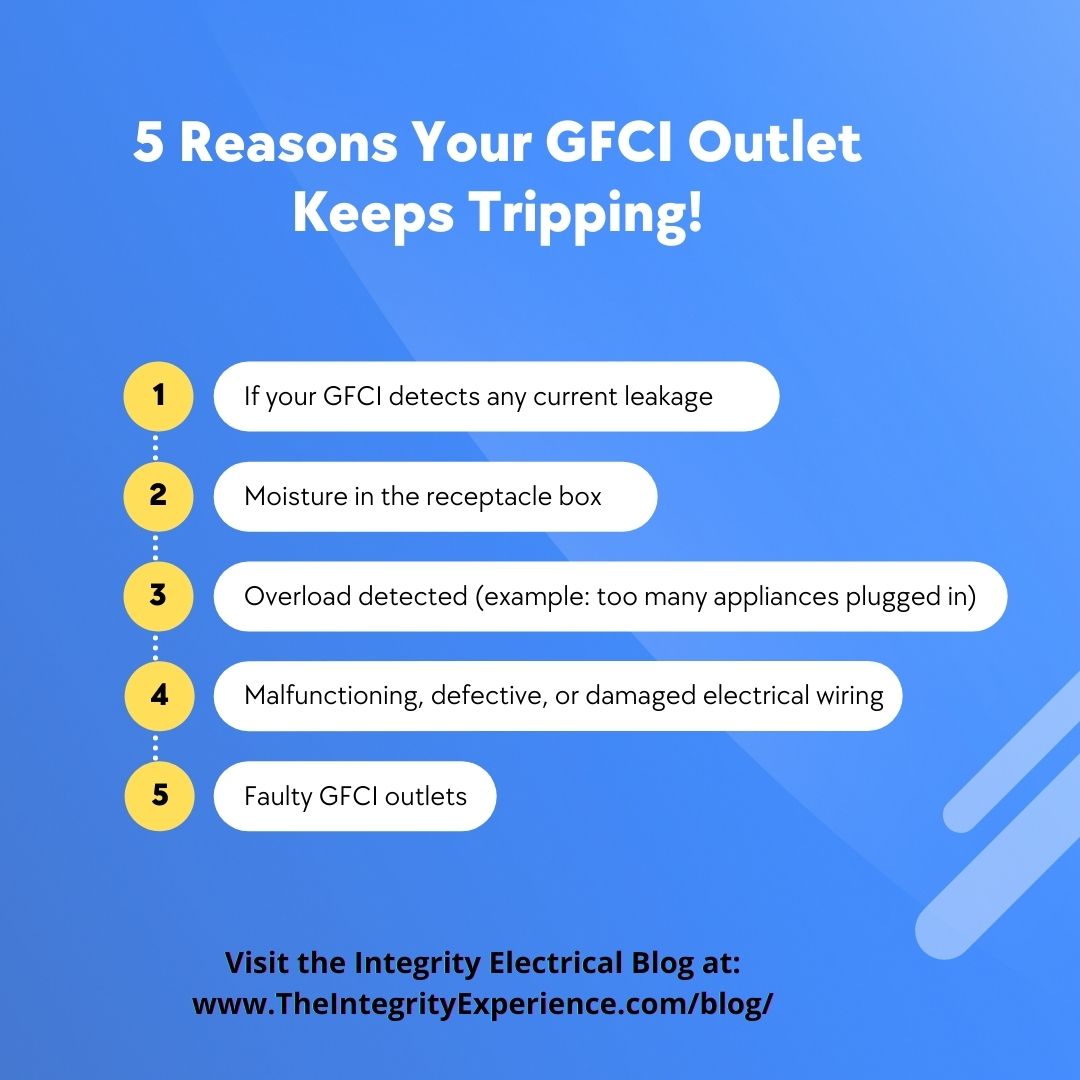
Why does my GFI keep tripping? How do I fix this? Do GFCI outlets go bad? These questions and more will be answered in this GFCI outlet guide.
Table of Contents –(GFCI Guide)
What is a gfci.
The ground-fault circuit interrupter (GFCI) is a fast-acting circuit breaker designed to shut off electric power in the event of a ground fault. GFCI outlets prevent a person from getting electrocuted when water comes in contact with an outlet. GFCI outlets are required anywhere outlets may contact water. For example, you’ll typically find GFCI outlets in bathrooms, basements, kitchens, laundry rooms, and garages.
According to Home Depot: “GFCI protection is required for 125-volt to 250-volt receptacles supplied by single-phase branch circuits rated 150 volts or less to the ground.”
Have you ever used the hairdryer near the sink with water in it and thought to yourself, “Would I get an electrical shock if I dropped the hairdryer in the sink?” And then you look over to the wall and notice a weird-looking outlet with a reset button on it. That’s a GFCI outlet.
Picture of GFCI Outlet
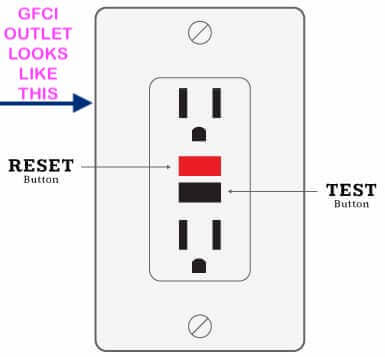
5 Reasons Your Ground-Fault Circuit Interrupter (GFCI) Outlets Keeps Tripping

- If your GFCI detects any current leakage, it trips automatically as a safety precaution. Technically speaking, this current leakage can be caused by a hot wire touching the ground somewhere on the electrical line.
- Moisture in the receptacle box is another common cause of a GFCI outlet tripping.
- When a GFCI outlet detects an overload, it trips. Overloads can occur from simply plugging too many devices in at once or having too much electrical current running at a given time on a particular circuit.
- Malfunctioning, defective, or damaged electrical wiring can result in a tripped GFCI outlet. As Integrity Electrical’s CEO, Joe O’Connell, says below, “GFCI outlets typically last 10-15 years. In my experience, if your outlets are that old, you should have them tested and inspected.”
- Faulty GFCI outlets can be due to age or a defective product. Unfortunately, bad GFCI outlets exist. Luckily they can easily be replaced using the standard 2-Year Limited Warranty for electrical outlets & receptacles.
GFCI Outlets and Electrical Safety
Electrical safety is always a top priority when it comes to the way manufacturers build most electrical devices. Electrical safety mechanisms, such as a GFCI, act as insurance, protecting manufacturers from getting sued.
What the law says about GFCI Outlets: National Electric Code (NEC):
How do you fix a gfci that keeps tripping.
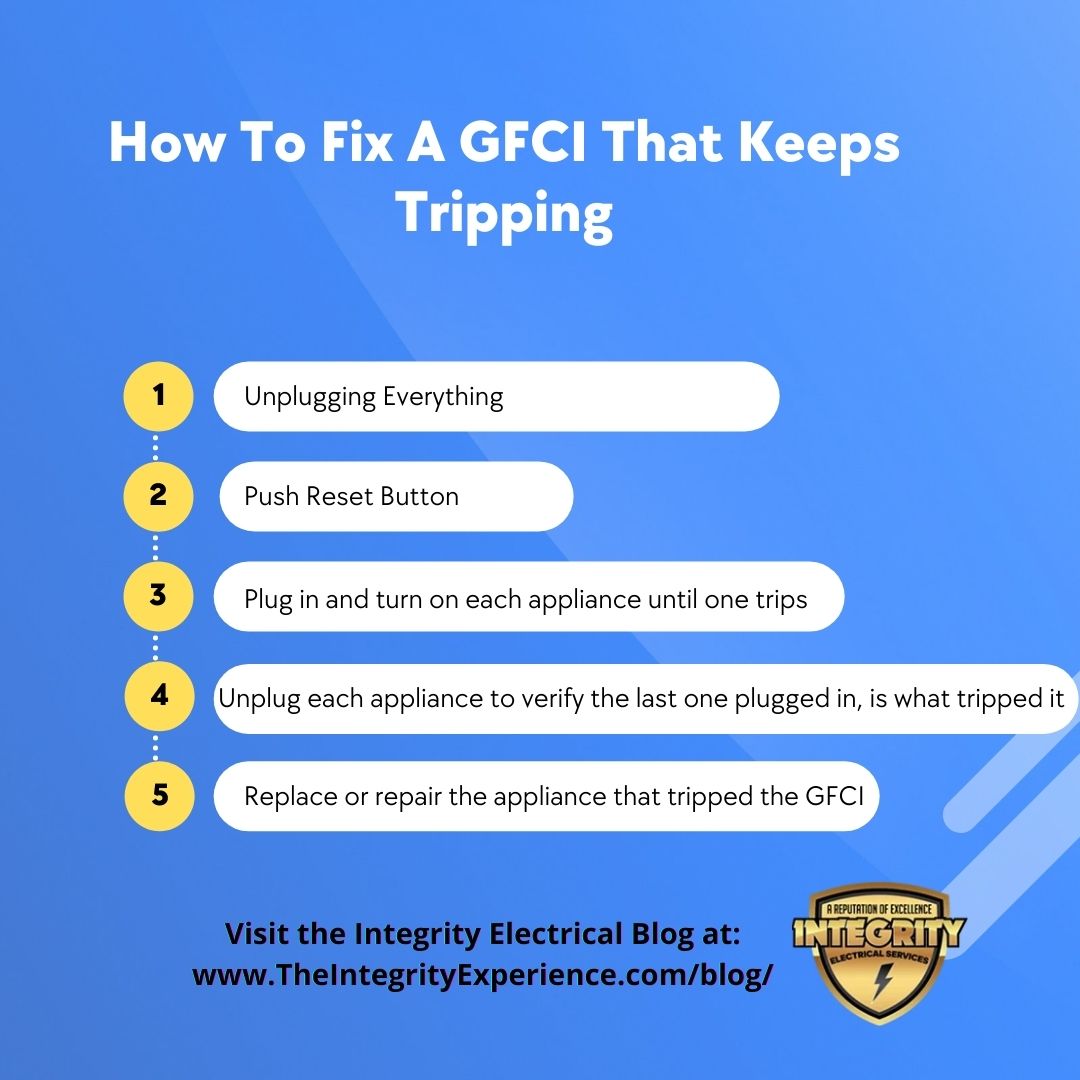
- Start by unplugging everything connected to that outlet’s circuit.
- Push the button that says “reset.”
- Troubleshoot the issue by plugging in and turning on each appliance until one trips.
- Unplug each appliance plugged in before the GFCI tripped to verify the last appliance you plugged in is what tripped the GFCI. If so, that appliance likely has a ground fault.
- Replace the GFCI outlet if it’s bad. Repairing a GFCI outlet is another option that only a licensed electrician should attempt to do. And if it’s a problem related to an overload on the electrical circuit, you could fix the problem by plugging in fewer appliances.
How to Install a GFCI Outlet
To install a GFCI outlet, you’ll need:
(1) a voltage tester
(2) a Phillips head screwdriver
(3) a GFCI receptacle
(4) electrical tape
(5) a wire stripper
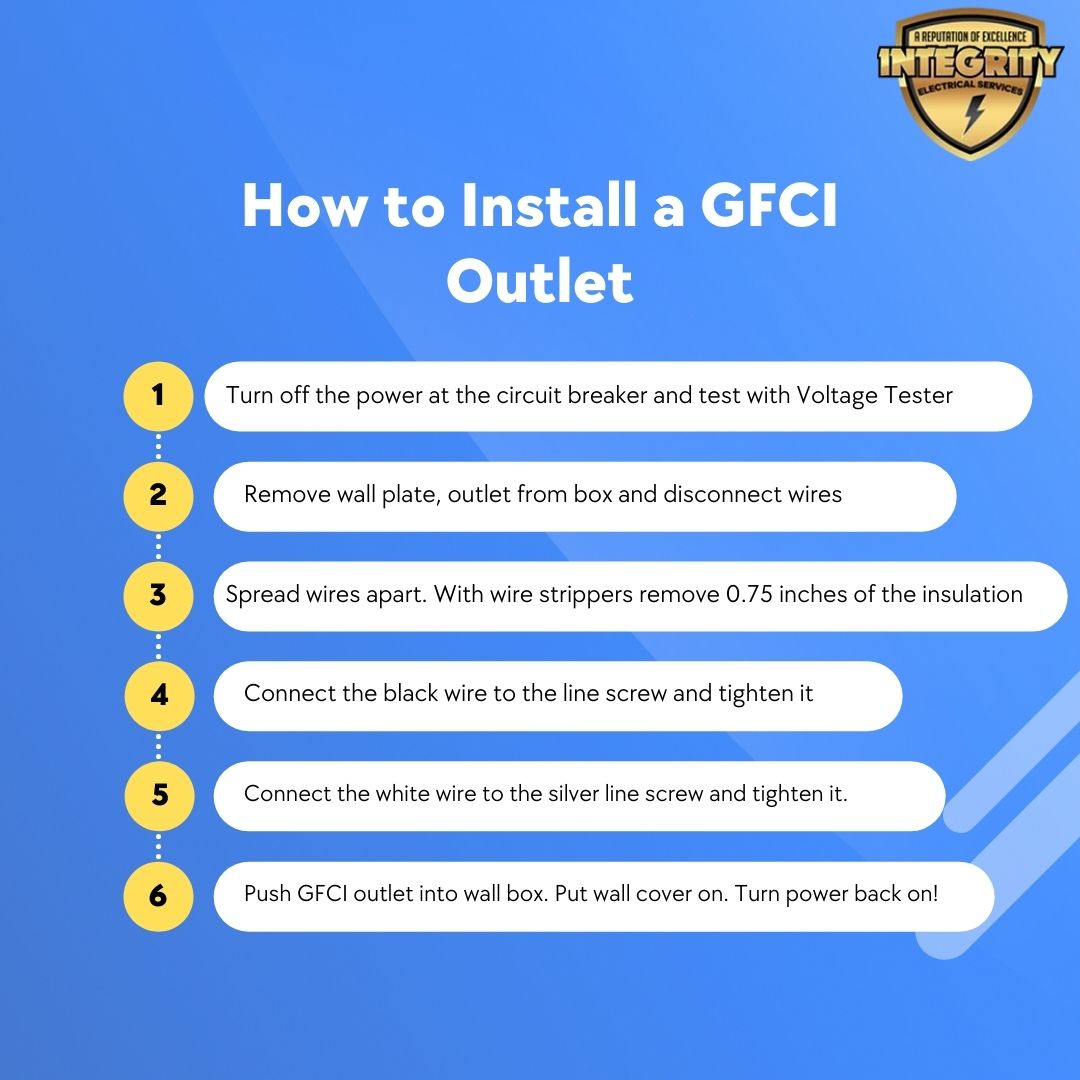
- Turn off the power at the circuit breaker inside your panel box.
- Use a voltage tester to confirm the power is off.
- Remove the existing wall plate by unscrewing the two screws holding the outlet in place.
- Remove the outlet from the box and disconnect the wires.
- Spread wires apart (there should be three wires) and use the wire strippers to remove three-quarters of an inch of the insulation (note: green = ground, white = neutral, and black = hot). Make sure to recognize which wire is coming from the main panel.
- Go back into your panel box and turn the power on.
- Touch each black and white wire using the voltage tester to ensure the tester lights up. Then turn the power back off. Now you’re ready to go!
- GFCI outlets have four terminals; two labeled “line” and two marked “load.”
- Connect the black (hot) wire to the brass screw and tighten it.
- Connect the white (neutral) wire to the silver line screw (terminal) and tighten it.
- Push the GFCI outlet into the wall box. Replace the mounting screws and put the cover back on.
- Turn the power back on and plug in your appliance to test it. And you’re done!
Source: Watch the Full Instructional Video at Home Depot Video Instructions How to Install GFCI Outlet
My GFCI outlet is not working?
According to Joe O’Connell, the owner of Integrity Electrical Services;
“GFCI outlets typically last 10-15 years. In my experience, if your outlets are that old, you should have them tested and inspected. Exposure to excessive heat, moisture, water, or UV light can cause GFCI outlets to fail over time. ”
GFCI outlets are unique outlets that have built-in circuit breaker protection. Therefore, if a short or overload occurs, not only the GFCI outlet goes bad, but all outlets around it could stop working.
Best case scenario: hit that reset button on the GFCI outlet, and it magically starts working again. But you’re not always going to be so lucky.
If your GFCI reset button doesn’t fix the problem, you may want to check for a tripped circuit breaker inside your electrical panel.
Have a question or need an electrician? Call one of our local and licensed electricians at Integrity Electrical Services a t (978) 753-8350 .
How to Check for a Tripped Circuit Breaker?
Open up your electrical panel box and check if one of the breakers is turned off or out of line with the rest.
If you find a breaker that’s turned off, turn it back on, and then off, and then on again. Make sure you hear that click each time you turn it on and off.
If the breaker turns on but then continues to trip, that’s not a good sign, and you could have a short in the line.
Detailed Troubleshooting for Dead GFCI outlets:
- Check other outlets to make sure it’s only the one that’s not working. Use a voltage tester if you have one.
- As mentioned above, head down to your circuit breaker box and check for any tripped breakers.
- If you find a tripped breaker, turn it on and off and then on again. If the breaker trips again, not staying on, you could have a severe problem.
- If you have a fuse box, check for any burned or blown fuses (note: blown fuses usually appear brown).
- Rest your GFCI outlet by using the test and reset button. First off, if the test button doesn’t pop back out after you press it, the GFCI outlet could be bad, or there could be no power to the GFCI.
- Make sure to push the reset button on all of your GFCI outlets, to verify all are working.
- Are you still getting no power? First, turn off your main breaker service inside your electrical panel box. Next, unscrew the GFCI outlet and look for loose wires and terminal screws. If you find a loose or burned wire, in this case, you may need to replace the outlet entirely. Don’t try replacing the outlet on your own; it’s not worth the headache and potentially looping together the wrong wires, resulting in a worse electrical problem.
Is your GFCI outlet continuing to trip?
If you’ve tried everything and your GFCI continues to trip, the underlying condition could be due to a current leak.
A current leak could be a sign of danger.
Please do not mess around in this case and play Mr. Electrician, trying to troubleshoot it on your own.
If you live in Massachusetts, one of our Wilmington-based electricians can help. Call (978) 753-8350 today. We service most cities and towns in Massachusetts (MA) and nearby Reading , Andover , and Woburn . Integrity Electrical Services was recently awarded #1 Rated Electrical Company in MA and is 5-star rated on Google . The company is also 5-star rated on HomeAdvisor with 99% approval ratings and A+ BBB.
Lastly, we’ll answer a few frequently asked questions about GFCI outlets.
Do GFCI Outlets Go Bad?
Yes, GFCI outlets go bad.
The average lifespan for a GFCI outlet is ten to fifteen years.
Therefore, if you have an older home, you’re more likely to experience GFCI outlets going bad.
Can a bad breaker cause a GFCI to trip?
No, but it won’t reset if you have any power.
Bob Johnson, a licensed electrician, stated, “Probably not. If the breaker is on the supply ‘LINE’ side of the GFCI, then no—keep looking for an additional problem on the ‘LOAD’ side of the GFCI. On the load side, I suppose a failed breaker could create a high resistance short to ground and trip the GFCI. But having a breaker on the load side would be unusual.”
Bottom line: If the breaker is bad, it’s not sending power to the outlet. That’s why you can’t reset it.
Mister Sparky, “Do GFCI outlets go bad?”, Mistersparkykc.com
Bob Johnson, “Can a bad breaker cause a GFCI to trip?”, https://www.quora.com/
5 Common Types of GFCI Outlets
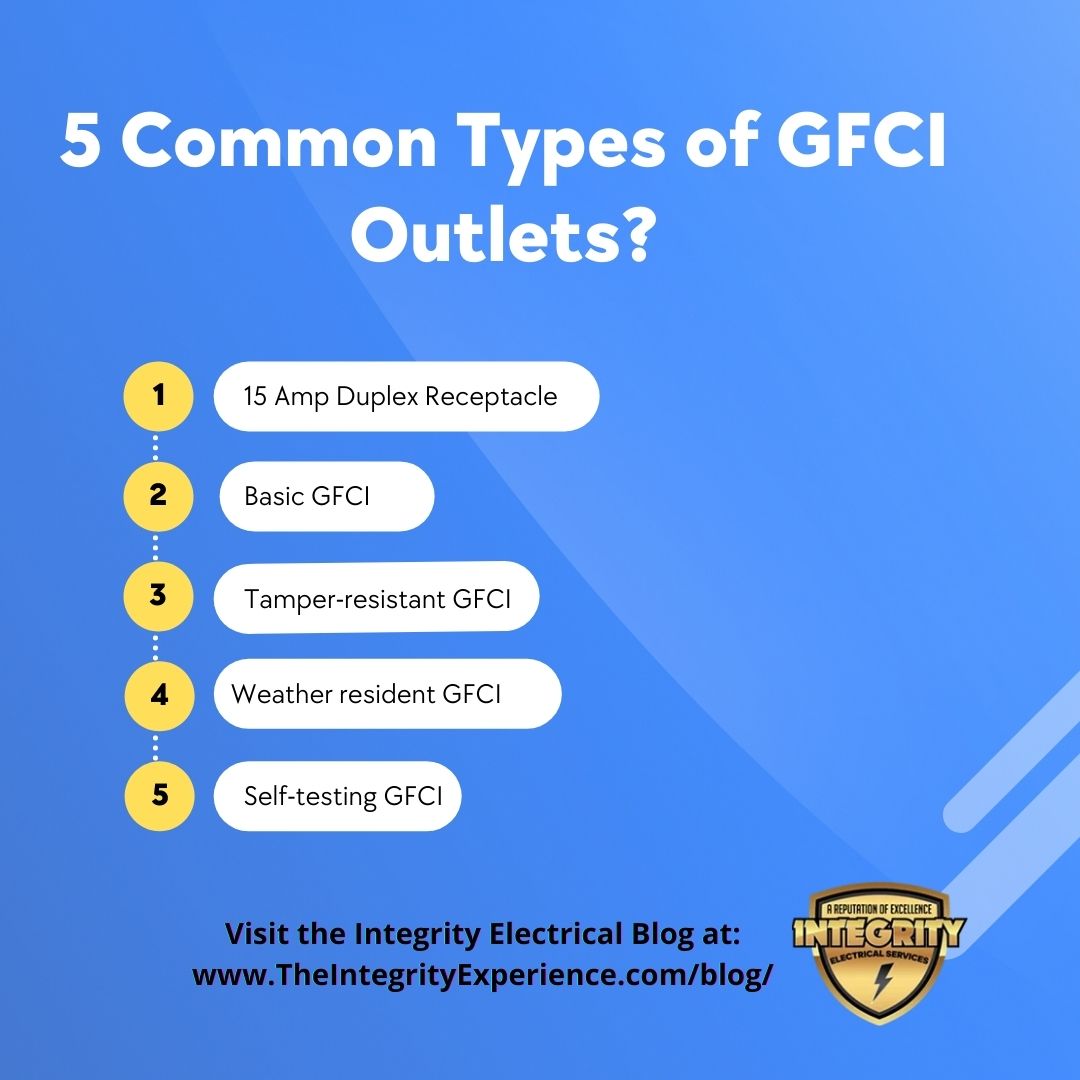
- (1) 15 Amp Duplex Receptacle (known as the standard electrical outlet, used in most homes in the United States)
- (2) Basic GFCI
- (3) Tamper-resistant GFCI
- (4) Weather resident GFCI (often used for outdoor areas, including porches, decks, and pool areas)
- (5) Self-testing GFCI
All of these GFCI outlets can be purchased from Home Depot or Lowes.
Source: Homeelectrical.com, What Are The Different Types Of GFCI Outlets?
- svg]:stroke-primary"> 826K
- svg]:stroke-primary"> 622K
- svg]:stroke-primary"> 246K
- svg]:stroke-primary"> 45K
All You Need to Know About GFCI Outlets
By: Glenda Taylor , Bob Vila
Updated on May 18, 2022 3:56 PM EDT
7 minute read
Photo: istockphoto.com
We may earn revenue from the products available on this page and participate in affiliate programs. Learn More ›
When it comes to electricity, safety has always been a major concern, but thanks to the development of ground fault circuit interrupter outlets (GFCIs), the risk of being severely shocked or electrocuted is greatly reduced. According to the Electrical Safety Foundation International (ESFI), electrocutions are down 83 percent since the 1970s when GFCIs were introduced. These quick-to-react outlets are required by law in new home construction, and it’s a good idea to put them in older homes as well. Read on for must-know info on GFCIs—what they are, how they work, and where to install them.
RELATED: These Electrical Safety Tips Could Save Your Life
What is a ground fault?
In your home, the flow of electricity is contained within wires covered with rubber- or plastic-based insulating material. When everything goes as planned, the electrical current runs safely through the insulated wires to switches and wall outlets and on to the many appliances and gadgets we take for granted today. But in its raw state, electricity has a “mind” of its own, and left to its own devices—as evidenced by most lightning strikes—it makes a beeline for the ground.
A ground fault is the occurrence of electricity taking an unintended path to the ground. It occurs when the electrical current escapes the insulated wires, as a result of a damaged cord or faulty wiring , and flows through a different conductor. If that different conductor is a human being, the result can be a serious electrical shock or electrocution. Because water is an excellent conductor of electricity, the risk of a ground fault occurring is greater in areas of your home where water is commonly used, such as near a kitchen sink.
How do GFCIs work?
The singular purpose of a GFCI outlet is to prevent electrical injury to humans, something regular outlets are not equipped to do. A standard household outlet features two, three-prong plug-in slots, while a GFCI outlet features the same plug-in configuration plus two buttons on its face: a “TEST” button and a “RESET” button. The rules requiring the installation of the GFCI outlets in new construction has expanded over the years to include more applicable locations:
1973 – exterior outlets 1975 – bathroom outlets 1978 – garage outlets 1987 – any outlet within six feet of a kitchen sink 1987 – at least one basement outlet 1990 – crawl spaces 1993 – wet bars 1996 – every kitchen outlet that serves a countertop 1999 – electrically heated floors
Normally, electrical current flows at a uniform rate through wiring, but when a ground fault occurs, the flow of electricity surges as it jumps to the unintended conductor. A GFCI outlet contains a sensor that monitors the flow of the electrical current through the wires, and when it senses a ground fault (in electrical terms, “fault” means any variation from the normal current), the GFCI, which also contains an internal switch, shuts off the flow of electricity in the outlet.
While you may still receive a painful shock, the GFCI will prevent a prolonged surge of electricity, the type that injures and kills. A standard outlet, like the type in your bedroom, doesn’t have a sensor.
Where should GFCIs be installed?
The National Electric Code (NEC) requires the installation of GFCI outlets in new construction in areas where electrical outlets are in close proximity to water. Older homes are not required to have GFCI outlets unless the wiring is being updated, but it’s a good idea to install them anyway.
The NEC requires GFCIs on all exterior and bathroom receptacles (another term for outlets). GFCIs are also required on all receptacles serving kitchen countertops. In laundry rooms and utility rooms, GFCIs should be installed on outlets within six feet of sinks, washing machines, and water heaters. They should also be installed within six feet of a wet bar and in garages and unfinished basements.
In bedrooms, living rooms, and other areas where water fixtures are not found, regular outlets are fine—and they are still installed in today’s new homes. The ESFI estimates that approximately 43 million homes in the U.S. still do not have GFCIs installed in “wet” rooms, and notes that as many as 47 percent of today’s electrocutions could be prevented in older homes if GFCIs were installed.
Can I install GFCIs myself?
A DIYer with basic knowledge of electrical wiring may be able to replace an existing outlet with a GFCI outlet (instructions below), but only when swapping out a three-prong outlet—two plugin slots and a hole. Outlets with only two slots and no third hole indicate the presence of older wiring that should only be replaced by a licensed electrician.
The other caveat is that only outlets connected to three wires are suitable for DIY replacement. Outlets with three attached wires (remove the outlet plate to determine the number of attached wires) indicate that the outlet is located at the end of an electrical circuit (a wiring loop that starts and finishes at the breaker panel). An outlet with five attached wires is located in the middle of an electric circuit, and the wiring process is more complicated—only a licensed electrician should replace those outlets.
A GFCI outlet runs about $15, such as this Levitron GFCI Outlet (available from Home Depot ). An electrician will charge an additional $50 to $100 dollars per hour to replace outlets.
Replacing a GFCI Outlet Yourself
Replacing an existing outlet at the end of a circuit (as explained above) is not particularly difficult, but the task requires some experience. You should understand how outlets are wired and how electrical current travels from the breaker panel through each electrical circuit (wiring loop) in your home. Some communities prohibit homeowners from doing their own wiring, so check with your local building authority before you start.
MATERIALS AND TOOLS – Flat screwdriver – Phillips screwdriver – Flashlight – GFCI outlet – GFCI outlet cover
Shut off the power to the outlet by turning off the circuit breaker (at the breaker panel) that provides electricity to the outlet. A good way to ensure that the power is off is to plug a nightlight into the outlet and turn it on, then shut off the breaker. If the nightlight does not go off, you’ve got the wrong breaker—try again.
Remove the outlet cover with a flat screwdriver. You’ll probably need a helper to hold a flashlight for you now, since the overhead light might also be off.
Remove the old outlet from the outlet box using a Phillips screwdriver. The outlet is typically held in place by two screws at the top and two at the bottom. When the screws are removed, the outlet will hang freely—the only things holding it are the attached wires.
Remove the three attached wires, which are held in place with Phillips screws. Note the color of the screws and the color of the wires .
- Black (hot) wire connects to a brass or gold screw on one side.
- White (neutral) wire connects to a silver screw on the opposite side.
- Green or copper (ground) wire connects at the bottom of the outlet to a green screw.
Attach the new GFCI outlet in the same way you disconnected the old outlet, making sure the wires attach to the screws using the above color-coded method. The GFCI outlet will also have two additional screws on the bottom sides, and these screws will be covered by a piece of tape. Leave the tape in place—these screws are for use by an electrician who is replacing an outlet in an advanced wiring situation.
Fasten the new GFCI outlet to the outlet box with Phillips screws (use the same holes).
Position the new GFCI outlet cover over the outlet and attach it with flat screws. A new outlet cover is necessary because the cover of a standard outlet will not fit a GFCI outlet.
Turn the circuit breaker back on.
Press the “Reset” button on the front of the GFCI outlet to turn it on and plug the nightlight in to test it.
Leave the nightlight in and then press the “Test” button. The nightlight should go off, which tells you that the GFCI outlet is working as intended. If it’s not working, it’s time to call the electrician.
How should I care for GFCI outlets?
Once installed, a GFCI outlet needs virtually no additional care, although you might want to press the Test button once a month or so to make sure it’s still functioning properly. Occasionally, a GFCI will shut itself off for no apparent reason—known as “nuisance trips” or “ghost trips.” This can be caused by something as simple as static electricity or nearby lightning. When this happens, just press the Reset button to restore electricity.
If a GFCI trips frequently when not in use (daily or weekly), the outlet itself could be worn out or faulty and should be replaced.
Anker’s New Home Battery Tower Is a Sleek, Modular Step Toward Complete Energy Independence Anker’s New Home Battery Tower Is a Sleek, Modular Step Toward Complete Energy Independence
By: Chase Brush
The 20 Best Lawn Care Products for a Lush and Healthy Lawn The 20 Best Lawn Care Products for a Lush and Healthy Lawn
By: Deirdre Mundorf
GFCI Outlet Keeps Tripping Without Load: Understanding the Issue and How to Fix It
Hey there! This post contains affiliate links to products. We may receive a commission for purchases made through these links. But it never influences our product selection process.
If you’ve been experiencing a problem with your GFCI outlet constantly tripping without load, it can be frustrating and even dangerous. A GFCI outlet is a type of electrical receptacle that provides protection against electrical shocks by interrupting the flow of electricity when it detects a ground fault. While it’s normal for a GFCI outlet to trip occasionally, especially when there’s a fault in the circuit, it’s not normal for it to trip repeatedly without any apparent load.
That there could be several reasons for a GFCI outlet to keep tripping even when there is no load connected to it. It could be due to a faulty GFCI outlet, a ground fault in the circuit, a wiring issue, a defective appliance or device, moisture, or even a faulty breaker.
Troubleshooting steps include inspecting the outlet and wiring for any visible damage, testing the outlet using the test and reset buttons, and checking for any defective devices or appliances that may be causing the issue. If the problem persists, it’s best to consult a professional electrician for further assistance.
In this article, we’ll explore the causes of this issue and provide some tips on how to fix it.
What is a GFCI Outlet and How Does it Work?
Before we delve into the causes of a GFCI outlet tripping without load, let’s first understand what a GFCI outlet is and how it works. A GFCI outlet is designed to protect people from electrical shocks caused by ground faults . A ground fault occurs when the current from the hot wire comes into contact with a grounded surface, such as a metal appliance or a person. This can happen when a circuit is damaged or when there’s a short circuit.
A GFCI outlet monitors the amount of current flowing between the hot and neutral wires. If it detects a difference of more than 5 milliamps, it will quickly interrupt the flow of electricity, thereby protecting people from electrical shocks. GFCI outlets are commonly used in areas where electrical appliances are used near water, such as in bathrooms, kitchens, and outdoor areas.
Why Does a GFCI Outlet Keep Tripping Without Load?
If your GFCI outlet keeps tripping without load, there are several possible reasons for this issue. Let’s take a look at some of the most common causes:
Faulty GFCI Outlet
One of the most common causes of a GFCI outlet tripping without load is a faulty outlet. Over time, GFCI outlets can wear out or become damaged, leading to false tripping. If you suspect that your GFCI outlet is faulty , you can try resetting it by pressing the “test” button and then the “reset” button. If the outlet still trips without any load, it’s likely that the outlet needs to be replaced.
Ground Fault
Another possible cause of a GFCI outlet tripping without load is a ground fault in the circuit. A ground fault can occur when the hot wire comes into contact with a grounded surface, such as a metal appliance or a person. This can happen when a circuit is damaged or when there’s a short circuit. If you suspect that there’s a ground fault in the circuit, you should call a licensed electrician to diagnose and fix the issue.
Moisture is another common cause of a GFCI outlet tripping without load. When water comes into contact with an electrical circuit, it can create a ground fault and cause the GFCI outlet to trip. If you have a GFCI outlet in a bathroom, for example, it’s important to make sure that the outlet and its surrounding areas are kept dry.
Overloading
Overloading is another possible cause of a GFCI outlet tripping without load. If you have too many appliances or devices plugged into the same outlet or circuit, it can overload the circuit and cause the GFCI outlet to trip. To prevent overloading, you should avoid plugging too many devices into the same outlet or circuit.
How to Fix a GFCI Outlet Keeps Tripping Without Load
If your GFCI outlet keeps tripping without load, there are several things that you can do to fix the issue. Here are some tips:
Check Other Outlets
If you have multiple GFCI outlets in your home, it’s possible that the issue is not with the outlet that keeps tripping, but with another outlet in the same circuit. You can try resetting all of the GFCI outlets in your home and see if that resolves the issue.
Inspect the Wiring
If you suspect that the issue is with the wiring, you should call a licensed electrician to inspect the wiring and diagnose the problem. Attempting to fix wiring issues on your own can be dangerous and should only be done by a trained professional.
Replace the Outlet
If the GFCI outlet is faulty and resetting it doesn’t solve the problem, you may need to replace the outlet. Make sure to turn off the power to the outlet before attempting to replace it, and follow proper safety precautions.
Reduce the Load
If overloading is the issue, you can reduce the load on the circuit by unplugging some of the appliances or devices that are connected to the same outlet or circuit. You can also consider adding more outlets to the circuit to distribute the load.
Keep the Outlet Dry
If moisture is the issue, you can prevent the outlet from tripping by keeping it and its surrounding areas dry. Make sure to use waterproof covers for any electrical appliances in areas where water is present.
GFCI Outlet Keeps Tripping After Reset
If your GFCI outlet keeps tripping after you have reset it, there are several possible reasons why this could be happening. Some of the most common reasons include:
Overloading the Circuit
One of the most common reasons why a GFCI outlet may keep tripping is because the circuit is overloaded. This can happen if you have too many appliances or devices plugged into the same outlet or circuit. To resolve this issue, try unplugging some of the appliances or devices and see if the GFCI outlet stops tripping.
Another reason why a GFCI outlet may keep tripping after being reset is that the outlet itself is faulty. Over time, GFCI outlets can wear out and become less effective. If this is the case, you may need to replace the outlet with a new one.
Moisture or Water Damage
GFCI outlets are designed to protect against electrical shocks in wet or damp areas. If the outlet is exposed to moisture or water damage, it can trip repeatedly, even after being reset. To prevent this from happening, keep the outlet and the surrounding area dry.
Wiring Issues
Wiring issues can also cause GFCI outlets to trip repeatedly. If the wiring is damaged, loose, or outdated, it can cause electrical shorts or other issues that can trigger the GFCI outlet. This is a serious issue that should be addressed by a licensed electrician.
Other Electrical Issues
There are several other electrical issues that can cause a GFCI outlet to trip repeatedly. For example, if there is a ground fault in the wiring or if there is a problem with the electrical system itself, the GFCI outlet may trip. If you are unable to identify the source of the problem, it’s important to call a licensed electrician to diagnose and fix the issue.
What to Do if Your GFCI Outlet Keeps Tripping After Reset
If your GFCI outlet keeps tripping after you have reset it, there are several steps you can take to address the issue. Here are some tips to help you troubleshoot the problem:
- Unplug any appliances or devices that are connected to the GFCI outlet. If the outlet stops tripping, the problem may be due to an overloaded circuit.
- Check the outlet for signs of moisture or water damage. If you notice any signs of water damage, such as rust or discoloration, you may need to replace the outlet.
- If the outlet is not visibly damaged, try resetting it again. If it continues to trip, you may need to replace the outlet with a new one.
- If none of these steps resolve the issue, call a licensed electrician to inspect the wiring and diagnose the problem. Attempting to fix wiring issues on your own can be dangerous and should only be done by a trained professional.
Frequently Asked Questions (FAQs):
Why does my gfci outlet keep tripping even when there’s no load connected.
There could be several reasons for this issue. It’s possible that there is a ground fault in the circuit, a defective GFCI outlet, or a wiring problem. It’s also worth checking if there are any moisture-related issues, such as water getting into the outlet.
How can I determine if the GFCI outlet is defective?
To check if the GFCI outlet is the problem, you can try replacing it with a new one. If the new outlet doesn’t trip, then the old outlet was likely defective. However, if the new outlet also trips, the issue might be with the wiring or another component in the circuit.
What steps can I take to troubleshoot wiring issues?
Start by checking the wiring connections at the GFCI outlet and any other outlets connected in the same circuit. Look for loose or damaged wires and ensure they are properly connected. It’s recommended to turn off the power before inspecting or working on the wiring.
Is it possible for a neighboring GFCI outlet to cause the tripping issue?
Yes, if multiple outlets are connected to the same GFCI circuit, a fault in any of them can cause the GFCI to trip. Check all the outlets connected to the same circuit and ensure they are functioning properly. Resetting all the GFCI outlets in the circuit may help identify and resolve the problem.
A GFCI outlet that keeps tripping without load can be a frustrating and potentially dangerous issue. Understanding the causes of the issue and taking proper safety precautions can help you diagnose and fix the problem. If you’re not comfortable with electrical work, it’s important to call a licensed electrician to diagnose and fix any issues with your electrical system. By taking proper precautions and staying vigilant, you can ensure the safety of yourself and your loved ones.
Hey, I’m Steven Jones, the founder, and writer of this site. I have worked in Electrical for the past 5 years. I also know how to save energy and how to troubleshoot our electrical devices. I hope you enjoy my blog.
Related Posts
Why are the ac and outlets not working in camper/rv [troubleshooting solutions], why does gfci green light on but no power explained, how to find a hidden gfci outlet, leave a comment cancel reply.
Your email address will not be published. Required fields are marked *
Save my name, email, and website in this browser for the next time I comment.

Why GFCI Keeps Tripping With Nothing Plugged In?
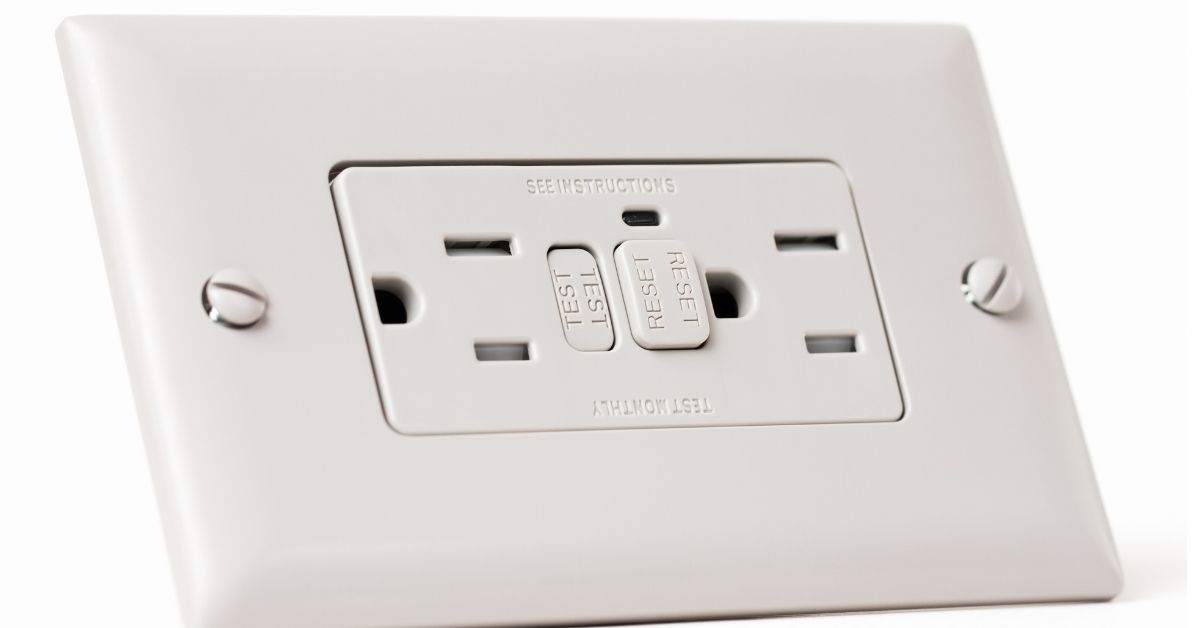
GFCIs will trip when they encounter a ground fault. But that is supposed to happen when you plug an appliance into the GFCI outlet. What happens when your GFCI starts tripping even though it doesn’t have anything plugged into it. Sometimes, the GFCIs are simply bad. But as the guide below will soon show you, that doesn’t apply to every single situation.
What Causes A Breaker To Trip When Nothing Is Plugged In?
You have to consider the possibility that the GFCI is defective or damaged. This happens all the time. Though, if you don’t believe that the GFCI has gone bad, It is also due to the damaged input wire. A damaged input wire can cause a leakage in the current.
A damaged input wire is not simply a nuisance. It is dangerous. Your GFCI keeps tripping because it wants to protect you. Stop resetting it until a professional resolves the problem.
Before you call a professional, you should check to ensure that nothing is plugged into the GFCI. Some homeowners attach GFCIs to every single outlet. Others use a single GFCI to protect multiple outlets downstream.
Even though the outlet with the GFCI doesn’t have anything plugged into it, if an outlet downstream is connected to an appliance, a defect in that appliance could cause the GFCI to trip , depriving all the outlets in the chain of power.
This is the reason why this configuration is so problematic. A fault in one outlet will affect all the outlets . The only way to conclude that you don’t have any devices plugged into the GFCI is to check all the outlets downstream .
If you have at least one appliance plugged into one of the outlets downstream, that appliance could be the cause of the incessant tripping.
What To Do If GFCI Keeps Tripping?
The solution you will apply will depend on the cause of the tripping, for instance:
1). Unplug Appliances
If you have an appliance plugged into one of the outlets downstream, unplug it. If the tripping stops, you can comfortably conclude that the appliance was the problem. If plugging other appliances into the outlet causes the GFCI to trip, the GFCI is the problem. If the appliance is at fault, unplugging it should resolve the situation.
2). Hire An Electrician
You have to hire an electrician. They will identify and then fix the source of the leakage.
3). Replace Defective GFCI
If the GFCI has gone bad, your only solution is to replace it. If you have the means, you should also consider installing a GFCI at each outlet. That way, a fault in an appliance plugged into one outlet won’t affect the other GFCI outlets.
How To Fix Tripped GFCI Outlet?
If the GFCI has tripped, the only thing you can do is to press the ‘RESET’ button. This will restore power to the GFCI outlet.
Related Post:
- Does Garbage Disposal & Dishwasher Needs GFCI?
- Can I Plug A Multi-Outlet Adapter Into A GFCI Outlet?
- How Many Outlets On GFCI?
- Can You Have 2 GFCI Outlets On the Same Circuit?
- Do Garage Outlets Need To Be GFCI Protected?
Why GFCI Outlet Keeps Tripping When I Plug Something In?
If your GFCI Outlets keeps tripping regardless of what you plug into it, one or more of the following might be the cause:
1). Loose Wiring
A loose connection in the GFCI outlet can cause nuisance tripping. Tripping is a good thing here because it is protecting you and your equipment . You should hire a professional to check the GFCI for other sources of current leakage. They may identify old and worn-out insulation in the GFCI.
2). Moisture
According to David Gray Online , if you have moisture in the GFCI outlet, it can cause incessant tripping. This can happen to outdoor outlets that have been exposed to rain.
It can also happen to indoor outlets in regions with a lot of humidity. Moisture will accumulate in the receptacle box. The GFCI will keep tripping until the water is removed.
3). Overload
If the appliances you keep plugging into the GFCI are too powerful, they can overload the GFCI by causing more current to flow through the outlet than it was designed to handle. On occasion, an overload occurs, not because the appliances are too powerful, but because of a loose or corroded connection. The GFCI will respond to the excess current by tripping.
4). GFCI Defect
If you rule out every other possible cause, you should consider the possibility that the GFCI has gone bad.
Some Other Problems Related To GFCI:
Gfci breaker tripping immediately.
If your GFCI trips immediately, regardless of whether or not it has something plugged into it, the GFCI is most likely defective. You should replace it. If the GFCI is fine, then it was probably not wired correctly. You need an expert that can open it to identify the source of the problem.
GFCI Keeps Tripping Breaker
The breaker in the GFCI can trip for several reasons, including a worn-out breaker, improper wiring, overloading, and a malfunction in the connected appliances, to mention but a few.
GFCI Outlet Keeps Tripping After Rain
If the GFCI is outside, the rain is introducing water to the outlet, causing a ground fault. If the GFCI is inside, you should look for a leak that allows water to enter your home whenever it rains.
If the GFCI outlet is covered to protect it from water, investigate the appliance. If the appliance has damaged jacketing, rain could introduce enough moisture to cause a short which, in turn, trips the GFCI.
GFCI Keeps Tripping In Rain
If the GFCI keeps tripping, rainwater is either infiltrating the outlet or the power cord. This can happen in situations where a homeowner has failed to add covers to exterior outlets. This can also happen if the power cord has damaged jacketing.
GFCI Trips Every Few Days
A GFCI can interpret a surge as a ground fault. This can cause it to trip. Surges are not always caused by poor wiring or a malfunction in the main power supply. You can cause surges in your home by activating a heavy-duty appliance.
Items like freezers use a lot of power when they first start. Once their power demands fall, the excess current they had drawn is redistributed throughout the circuit. This can result in a surge.
If you have heavy-duty appliances that you use once every few days, they may be responsible for the trips you encounter every few days. If surges are not the problem, check the GFCI receptacle box for moisture, debris, and insects.
GFCI Keeps Tripping For No Reason
You can blame random, unexplained tripping on moisture in the receptacle box, worn-out insulation, overloading in the circuit, and a defective GFCI. Conductive dust and debris in the outlet can also produce a ground fault.
GFCI Trips Right Away
The GFCI is either defective or has a loose connection. You should keep an eye out for worn-out or damaged insulation, not to mention water and debris in the receptacle.
GFCI Trips Randomly
The issue of a current leakage caused by old or damaged insulation causes GFCI to trip randomly.
The Places Where GFCI Can Trip
- Bathroom outlets have moisture in their vicinity. More than likely, water has infiltrated the bathroom outlet, causing a ground fault.
- If the bathroom outlet is just one among many protected by a GFCI upstream, you should consider the possibility that another appliance plugged into one of the outlets outside the bathroom is causing the GFCI to trip, depriving all the outlets of power, including the ones in the bathroom.
- Look for sources of moisture. A heavy storm can introduce water to the interior of a garage. If that water infiltrates the GFCI outlet, it will trip whenever you use it.
- Insects and other types of debris in the receptacle box can produce a similar result.
- You should also check the appliances plugged into the outlet. Large items with motors such as refrigerators have a tendency to cause nuisance tripping in GFCI outlets.
- The kitchen can expose an outlet to water and debris, resulting in a ground fault.
- If the water is not the problem, check the appliances. Fridges have a reputation for causing GFCIs to trip.
- If the fridge isn’t the problem, heavy-duty appliances like microwaves can trip a GFCI by drawing more power than it can handle. They will do this not only because they are powerful items but also because of a malfunction.
If you keep heavy-duty items such as water heaters and sump pumps in the basement, their combined load can cause either the GFCI or the circuit breaker to trip. It is also worth noting that basements are typically damp places that encourage moisture to either infiltrate or accumulate in the receptacle box, eventually resulting in a ground fault.
It is due to poor grounding or reversed polarity. A defect, malfunction, or improper wiring is causing leakage to the ground.
Common causes of tripping in this situation include a bad heating element (as well as a heating element short), loose connectors, burnt wires, and corrosion (of the electrical contacts). Naturally, if water from the tub enters the GFCI, it will trip.
The GFCI will trip because loose connections, worn insulation, moisture, contact with human skin, or some other defect has caused an electrical leak.
The appliances plugged into the GFCI, such as fridges and converters, can cause it to trip. Other potential causes include faulty wiring, loose connections, and a faulty GFCI.
Heated Floor Thermostat
The improper wiring can cause tripping in the GFCI. The issue on a short to ground as well as a conflict in the power supply circuit.
Stellar Jackson
Leave a Reply Cancel reply
Your email address will not be published. Required fields are marked *
Save my name and email in this browser for the next time I comment.
Recent Posts
Can You Run 120V And 480V In The Same Conduit? Is it Safe?
Yes, you can run 120V and 480V in the same conduit, and your local code will most likely permit the practice. Some people disagree. They think the NEC and other electric codes are designed to set the...
Can I Use 6/3 Wire For Hot Tub?
You can use 6/3 wire for a hot tub for 55 amps or less. I recommend 4AWG for 60A hot tubs to be on the safe side. Ensure proper grounding and consult an expert to match the wire gauge with your hot...
Home » circuit breaker » GFCI tripping
GFCI outlet Keeps Tripping: Causes and How to Fix It.
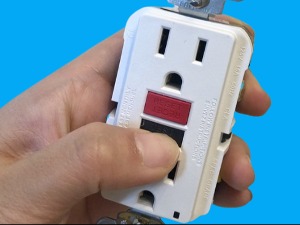
Ground fault circuit interrupters protect against electric shock. If your own gfci outlet keeps tripping, read on to find out why.
A ground fault circuit interrupter (GFCI) trips when it detects a ground fault , or current leakage even as little as 5mA between the hot and ground wire .
When the gfci detects the leakage current, it trips to protect you and the appliances plugged into the outlet.
The National Electrical Code recommends GFCI installation in every home, mostly in the bathroom and kitchen, to prevent electrocution and damage to appliances.
Related post : How to Install a GFCI Outlet in your Bathroom and Kitchen
Table of Contents
What causes a GFCI outlet to keep tripping?
A gfci device trips for so many reasons such as:
Ground faults
Ground faults occur when currents take an unintended path to the ground. Or when a hot wire touches the earth . When the ground fault occurs, currents leak to the ground.
The function of the GFCI receptacle is to detect when currents flow through an unintended path, which may be water or human.
Once the receptacle detects the current leakage, even as little as 0.005 amps, it shuts down.
This ground fault protection from the GFCI device helps protect us from electrical shock.
Related post: Circuit breaker keeps tripping without load . Causes and how to resolve them.
Causes of ground fault
- Faulty wiring
- Water touching the outlets or any naked cable.
- Worn out insulation.
Consult a qualified electrician to find the cause of the breaker trip.
Overload Circuit
Circuit overload occurs when you plug more appliances into a circuit than it can carry. Normally, a GFCL outlet handles between 15 and 20 amps. When you plug-in devices that draw more current than required, it trips the gfci.
Many things can cause circuit overload, including defective appliances, rusted wires, permanently installed electric motors, and others.
To see if the load is causing the tripping issues, do:
- Unplug the appliances plugged into the electrical outlet.
- Reset the gfci by pressing the reset button and wait for a few minutes to see if it will go off again. If it does, other faults may be responsible, but if it doesn’t trip, suspect the load.
- Plug back the appliances and watch if it goes off again. If it is the load that is causing the tripping, reduce it.
Wet receptacles
Since water is an excellent conductor of electricity, it can cause your outlet to trip. A wet receptacle can allow currents to flow through it to the ground, leading to loss of current.
This loss can vary the amount of currents going in and out of the circuit. Thus causing your GFCI to trip.
Electrical fault
If your GFCI breaker continues to go off, there may be an electrical issue arising from wrong connection.
Faulty connections can cause a current to leak to the ground, leading to a ground fault.
Faulty GFCI outlet
If, after trying the above methods, the GFCI still trips, replace the receptacle box with a new gfci.
You can buy a new outlet here@ Amazon
Call a licensed electrician to replace the outlet to avoid faulty connections.
You can also contact us at mariaelectrical.com to troubleshoot and replace the outlets for you.
How to troubleshoot and fix a tripping ground fault circuit interrupter (gfci)
Here are some steps you can take to fix a tripping GFCI:
Check the appliances
Unplug all the appliances connected to the GFCI and check if any part or wire is bad. A damaged wire or device can short circuit , causing the outlet to trip. If there is fault, change or replace the wire.
Check for overload
A GFCI can only handle a certain amount of electrical load . If you have too many appliances or devices connected to the outlet, it may trip. Try unplugging some devices and see if that fixes the problem.
Look for loose connection or bad wiring
Remove the plate cover from your outlet and inspect the wire connection. Make sure that the wiring is OK. And there is no loose connection or burnt wire.
If you are not familiar with wiring, call an electrician to inspect the wiring.
Check for moisture
GFCIs outlets trip when they detect moisture or water, make sure the environment is dry. If it is wet, clean it with dryer so that it will not conduct electricity.
Test and reset the gfci outlet
Press the “Test” button on the outlet to trip it. Then press the “Reset” button to restore power. If it trips again, the GFCI may need to be replaced.
Call a qualified electrician for assistance.
Mariaelectricals offers a range of electrical services and inspections. We have professionally trained and licensed electricians for your electrical work.
If your gfci outlet is constantly tripping, contact us to schedule an appointment .
Related articles
- What are the Differences Between Circuit Breakers and GFCIs?
- GFCI Won’t reset, 7 Causes and How to Fix it.
- Ungrounded Outlets Explained! Dangers and How to Fix the Issue.
About mariaelectricals
Hi, I am Emmanuel Nwankwo, a commercial electrician and the founder of mariaelectricals.com . I established this blog to share my decades of work experience in electrical installations and repairs.
Why Does My GFCI Keep Tripping with No Load? Understanding the Reasons
Jan 30, 2023
Filed under : GFCIs
Have you ever had an electrical outlet that just wouldn't cooperate? You plug something in, and the GFCI (Ground Fault Circuit Interrupter) trips, even when there's no load on it. It can be frustrating and confusing, but there are reasons why it happens. In this article, we'll take a closer look at why your GFCI might keep tripping with no load, and what you can do about it.
Table of Contents
Introduction, what is a gfci, faulty gfci outlet, overloading the circuit, ground fault in another outlet, water damage, faulty appliance, how to troubleshoot a gfci that keeps tripping with no load.
A GFCI outlet is designed to protect you from electrical shock by shutting off power to the outlet when it detects a ground fault. This is a critical safety feature that can save your life. However, sometimes a GFCI outlet can trip for no apparent reason. When this happens, it can be frustrating and inconvenient. In this article, we'll explore some of the reasons why a GFCI outlet might keep tripping with no load, and what you can do about it.
Before we dive into the reasons why your GFCI might be tripping with no load, let's quickly review what a GFCI is. A GFCI outlet is designed to protect you from electrical shock by shutting off power to the outlet when it detects a ground fault. A ground fault occurs when there is a path for electrical current to flow from a grounded source (such as a metal appliance) to a person. This can happen if there is a fault in the wiring or if an appliance is damaged.
Reasons Why a GFCI Keeps Tripping with No Load
There are several reasons why a GFCI might keep tripping with no load. Here are the most common ones:
Sometimes, the GFCI outlet itself is faulty. If this is the case, the outlet will need to be replaced. This is especially true if the GFCI outlet is old or has been exposed to water.
Another common reason why a GFCI might trip with no load is that the circuit is overloaded. If you have too many appliances plugged into the same circuit, it can overload the circuit and cause the GFCI to trip. To prevent this from happening, try unplugging some of your appliances and see if that fixes the problem.
Sometimes, a ground fault in another outlet can cause the GFCI to trip, even if there's no load on the GFCI outlet. This can happen if the other outlet is connected to the same circuit as the GFCI outlet. To troubleshoot this issue, you'll need to go around your home and check all the other outlets connected to the same circuit. Look for any signs of damage or water exposure, and make sure all the outlets are working properly.
Water damage can cause a GFCI outlet to trip, even if there's no load on the outlet. If the outlet has been exposed to water, it may need to be replaced. Water can damage the wiring and cause a short circuit, which can trip the GFCI.
Finally, a faulty appliance can also cause a GFCI to trip, even if it's not plugged into the GFCI outlet. If you have an appliance that's damaged or has a short circuit, it can cause the GFCI to trip. To troubleshoot this issue, unplug all your appliances and then plug them back in one at a time until you find the one that's causing the problem.
If your GFCI outlet keeps tripping with no load, here are some steps you can take to troubleshoot the issue:
- Unplug all your appliances and try resetting the GFCI outlet. If it doesn't trip, then one of your appliances is causing the problem.
- If the GFCI outlet still trips with no appliances plugged in, try resetting it again and then plugging in one appliance at a time until you find the one that's causing the problem.
- Check all the other outlets connected to the same circuit and look for signs of damage or water exposure.
- If none of these steps solve the problem, you may need to replace the GFCI outlet.
Remember, electrical work can be dangerous, so if you're not comfortable troubleshooting the issue yourself, it's always best to call a licensed electrician.
If your GFCI outlet keeps tripping with no load, there are several reasons why this might be happening. It could be a faulty outlet, an overloaded circuit, a ground fault in another outlet, water damage, or a faulty appliance. By following the troubleshooting steps we've outlined in this article, you should be able to identify the problem and fix it.
Q: What is a GFCI outlet?
A: A GFCI outlet is designed to protect you from electrical shock by shutting off power to the outlet when it detects a ground fault.
Q: Can a GFCI outlet go bad?
A: Yes, a GFCI outlet can go bad over time, especially if it's old or has been exposed to water.
Q: Why does my GFCI outlet keep tripping?
A: There are several reasons why a GFCI outlet might keep tripping, including a faulty outlet, an overloaded circuit, a ground fault in another outlet, water damage, or a faulty appliance.
Q: How do I troubleshoot a GFCI outlet that keeps tripping?
A: To troubleshoot a GFCI outlet that keeps tripping, unplug all your appliances and try resetting the outlet. If it still trips, try plugging in one appliance at a time until you find the one that's causing the problem. Check all the other outlets connected to the same circuit and look for signs of damage or water exposure. If none of these steps solve the problem, you may need to replace the GFCI outlet.
Q: Can I replace a GFCI outlet myself?
A: Electrical work can be dangerous, so if you're not comfortable working with electricity, it's always best to call a licensed electrician. However, if you have some experience with electrical work and feel confident in your abilities, you can replace a GFCI outlet yourself.
- "GFCI Outlets: What You Need to Know." The Spruce, 2021, https://www.thespruce.com/what-is-a-gfci-outlet-1152632 .
- "Why Does My GFCI Keep Tripping?" Mr. Electric, 2021, https://www.mrelectric.com/blog/why-does-my-gfci-keep-tripping .
- "How to Test a GFCI Outlet." This Old House, 2021, https://www.thisoldhouse.com/electrical/21017476/how-to-test-a-gfci-outlet .
- "Why Is My GFCI Tripping?" HomeTips, 2021, https://www.hometips.com/repair-fix/gfci-tripping.html .
- "GFCI Protection - How it Works and How to Test It." Electrical Construction & Maintenance, 2021, https://www.ecmweb.com/content/gfci-protection-how-it-works-and-how-test-it .
Leave a comment:
Net orders checkout, shipping address, shipping methods.
HIGHEST RATED ELECTRICIAN IN TOPEKA & LAWRENCE!
- 785-215-8775
- [email protected]
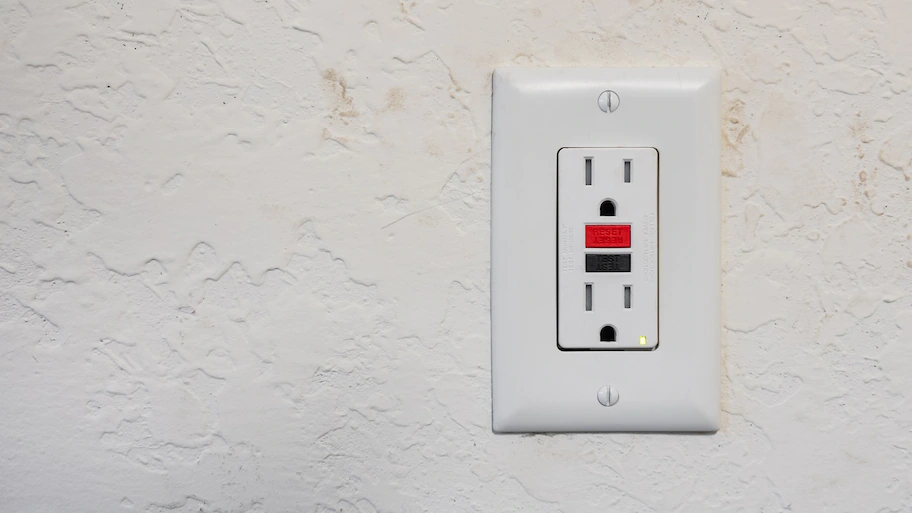
How Do GFCI Outlets Work & What Causes A GFCI to Trip?
Customers often ask our CWC Electric, LLC electricians how GFCI outlets work and what causes them to “trip” or stop working. Troubleshooting non-functioning GFCI outlets are a common electrical service call which can be expensive and frustrating to homeowners.
GFCI stands for G round F ault C ircuit I nterrupters and it was designed by Charles Dalziel in 1961. Mr. Dalziel was a professor of electrical engineering at UC Berkeley and wrote The Effects of Electric Shock on Man , a treatise which explained the effects of varying amounts of electricity on humans. Mr. Dalziel apparently knew a thing or two about how much electricity it took to kill a person and developed a device designed to protect human lives. In contrast, circuit breakers were designed to protect equipment and buildings and operate completely differently.
Here’s a mini-lesson on electricity: All electricity attempts to return to its original source. In other words, when an electrician refers to a circuit, he is talking about electricity leaving your panel, flowing through the insulated wires in your house to supply power to any energized items and then following a return path back to the panel. Circuit simply refers to a roughly circular route that starts and finishes at the same place…in this case, your electrical panel.
A GFCI outlet measures the power coming in and then returning to your panel as it completes the circuit. It was designed to detect any difference more than 4 or 5 milliamps and to react quickly (less than one-tenth of a second) to shut down any circuit out of this small range.
For reference, there are 1,000 milliamps in an amp. Any current over 1 milliamp can be felt, 5 milliamps will produce a painful shock, currents at 10-15 milliamps can paralyze or freeze muscles (making it impossible to release an energized object such as a tool, appliance or wire) and currents as low as 50-100 milliamps can be fatal. If a person is accidentally exposed to electricity, it is very important to stop the flow of electricity into the body as fast as possible. Each year there are an average of 400 home related electrocutions, about 60 which are associated with consumer appliances.
When a GFCI “trips” it is working as designed. If the GFCI’s internal current transformer senses more than a 4-5 milliamp loss, it instantly shuts down the outlet and any outlets it feeds to prevent accidental electrocution. Most often, when a GFCI “trips” it is the result of a faulty appliance plugged into the outlet or an outlet down circuit. Before calling an electrician, you may want to try this simple diagnosis: Unplug all appliances plugged into or down circuit from the GFCI, reset your GFCI by pushing the button in the center of the outlet and then plug the appliances back into the GFCI one at a time and turn them on to see if any of the appliances are causing the appliance to “trip”. If you plug in your coffee maker and the GFCI immediately trips, it is likely you have a faulty appliance and the GFCI is operating as designed.
All man-made objects have a lifespan and eventually wear out. It is recommended that all GFCI’s should be tested monthly to ensure they are operating correctly. Simply push the TEST button to turn power off to the circuit which should cause the RESET button to pop up. You will need to hit RESET to turn the GFCI back on. Do not assume that because an outlet is working that the GFCI protection is in effect. Newer have an interlock to prevent the outlet from working if the GFCI protection fails however older GFCI outlets do not have this built-in failsafe.
GFCI outlets should be installed in any area where moisture can be potentially present, examples include kitchen countertop outlets, bathroom outlets, all exterior outlets and garages. Your electrician may suggest additional areas where GFCI protection is recommended or required by the National Electrical Code.
Share This Post

CWC Electric
- 4100 SW Topeka Blvd. Topeka, KS 66609

- ©2024 CWC Electric, LLC, All Rights Reserved
- Privacy Policy
- Cottonwood Whispers Design

Welcome to CWC Electric, LLC
How can we help you today?
Why Does my GFCI Outlet Keep Tripping?
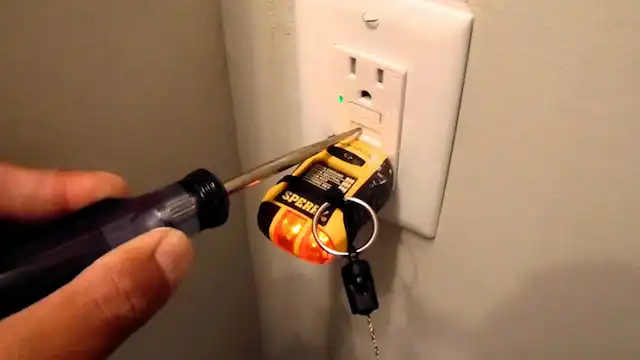
It is important to know how to troubleshoot your GFCI outlet if, for whatever reason, it starts to trip. After all, GFCI receptacles are meant to prevent electrical ground faults by disconnecting any electricity that could flow through the outlet.
No matter how small or large the electrical current, ground fault circuit interrupters are designed to quickly disconnect all power leading to the outlet. This is why it is very important to check your GFCI outlets to be sure that they are working properly. You can do so by pressing the “test” and “reset” pushdown buttons.

GFCI outlets are commonly used in wet or damp areas, such as kitchens, bathrooms, pool houses, and other outdoor areas. The National Electrical Code, or NEC, sets the electrical standards for GFCI outlets, from how they should be installed to where you should install them.
Article 210.8 states that all GFCI receptacles can be used for any 125-volt, single-phase, 15-amp or 20-amp electrical outlets.
If your GFCI outlet is continually tripping, it could probably benefit from some further investigation. It’s no secret that like most things, GFCI outlets do not last forever. In fact, although they can have a lifespan of about 15 to 25 years, some GFCI’s can fail as early as 5 years. Electrical trips, also known as ground faults, can occur for the following reasons:
- Worn out insulation
- Conductive dust or debris
- Electrical wiring deterioration

You should try to look for what is causing the leak in the electrical current. If your insulation is worn out, old, or damaged, it could cause your GFCI to trip. The insulation is in the wall is meant to help prevent such leaks from occurring. So if your insulation is worn, this can cause more leaks.
Sometimes having too much equipment or appliances plugged in can also cause your GFCI to trip. You can test this easily by using a leakage current clamp meter. This meter will measure the amount of electricity flowing through circuit and will help you diagnose what is causing your electrical outlet to trip. You can also use a ground fault receptacle tester as well.

- Remove the GFCI outlet and replace it. If the problem is fixed, then you know that the GFCI was the initial cause of the tripping.
- If removing the outlet, and the problem persists, it is likely that it could be another outlet on the line, or the circuit breaker itself.

GFCI outlets are extremely easy to replace and are much more cost effective than replacing an entire circuit board. You may even want to consider a self-testing GFCI outlet. For your own safety, never do any electrical work that you are uncomfortable with. Always call an Electrician!
Recommended Reading
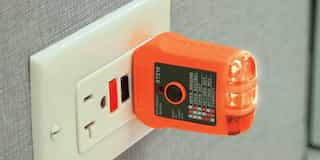
How Often Should You Test Your GFCI Outlets?
Routine testing can ensure your GFCI outlets work properly as well as let you know when it's time to replace them.
.jpg&w=320&q=50)
Which GFCI Do I Use and Where?
Explore the crucial aspects of GFCI outlets with our essential guide. From understanding their function to practical tips, this guide is your go-to resource for navigating the world of GFCI outlets.

The Advantages of Installing GFCI Outlets
The National Electric Code (NEC) requires that all home have ground fault circuit interrupters, or GFCI outlets. These outlets detect electrical leaks and shut off the power if danger arises, which keeps your home and your electrical devices safer.

A true creative with a penchant for the spiritual and natural order. She loves the Earth, almost as much as she loves writing about it.
Recommended Products
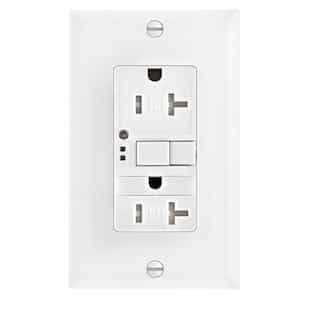
Receive special deals and more, right to your inbox
- Track My Order
- About HomElectrical
- Return Request
- © 2011-2021 HomElectrical Electric Supply. All Rights Reserved.
- 1590 N Roberts Rd, Ste 110, Kennesaw, GA 30144
- 888.616.3532

- Expert Tips
Fix a GFCI Outlet That Keeps Tripping
March 3, 2023
How to Fix a GFCI Outlet that Keeps Tripping
You likely have multiple GFCI (ground fault circuit interrupter) outlets to keep your Denver house safe and up to code. While most will be in potentially wet rooms, such as the kitchen or bathroom, you may also have opted to increase safety by adding them to other rooms. If these safety outlets keep tripping even when there appears to be no danger, there may be a danger you don’t see.
Here are some possible triggers that could be tripping your GFCI outlets and which situations you can solve without professional assistance.
Why Does My GFCI Outlet Keep Tripping?
While several things can trip a GFCI outlet, their core purpose is to prevent ground faults in the circuit. A ground fault occurs when a leak of energy flows outside the intended path. The GFCI will cut power to the electric flow to prevent electric shock or fire. These are a few possible reasons your GFCI outlet keeps tripping after a reset:
Moisture inside the outlet. An outlet exposed to weather or in a room where it could have contact with water—such as the bathroom or laundry room—may trip if moisture gets inside. If this happens, allow the outlet to dry completely before attempting to reset.
Dust or debris. If the GFCI gets clogged with dust or debris, it will disrupt the electricity. This disruption prevents fire hazards where the detritus overheats, catches flame, and prevents damage to your appliances. Before resetting the outlet, use a soft-bristled brush to dislodge the dust.
Worn or damaged wires. Whether from a rodent chewing in the walls or from regular wear, the rubber insulation on your home’s wires can become damaged. The unprotected wire may overheat and spark a fire behind the wall or allow a flood of energy to potentially fry the appliance on the other end if not stopped by your GFCI outlet. You can identify damaged wires by the smell of burning plastic or an outlet cover that feels warm to the touch. If you suspect this is the reason your GFCI keeps tripping, call a trusted electrician to repair the wiring.
Old or faulty outlet. GFCI outlets commonly last for 15-25 years. However, a defective outlet can give out after only a few years. If the GFCI malfunctions and regularly trips itself, consider replacing the receptacle.
Ground fault in the circuit. GFCI outlets prevent ground fault circuits by design, cutting power to potentially dangerous circuits that could cause an electric shock. Then, it’s left to you (or a professional) to identify the ground fault's source. In most cases, a ground fault occurs when an appliance is damaged or wet where it’s not supposed to be.
How to Reset and Test a Tripped GFCI: Step by Step
Once you know the outlet is free of dust and moisture, you can run the GFCI through this test to determine if your outlet is faulty or has a ground fault in the circuit.
Unplug all appliances from the circuit.
Press the GFCI reset button on the center of the receptacle.
One by one, plug in and turn on each device. When the GFCI trips, there are two possibilities: either the last appliance you plugged in is leaking electricity and causing a ground fault, or the number of devices is overloading the circuit.
Unplug all of the devices and reset the outlet.
Plug only the last device back in. If the circuit trips with only one machine, it has a ground fault and should be repaired or replaced. Certain appliances and electronics are eligible for recycling in Denver .
Find Certified Electricians in Denver
You may need more specialized assistance if your GFCI outlets continue to trip after troubleshooting the issue. At Mister Sparky of Denver, our electricians are skilled at troubleshooting and repairing electrical outlets . For quick and precise service, please request an appointment online or call us at (303) 747-4279 .

IMAGES
VIDEO
COMMENTS
What causes a GFCI to trip. When a GFCI outlet keeps tripping, there must be a reason. Instead of just resetting the GFCI, you should also investigate the cause of the trip. Ground Faults: Ground faults occur when electrical current finds an unintended path to ground. These are often caused by worn insulation, conductive dust, water, or other ...
Updated on February 17, 2024. There are several different reasons why a GFCI keeps tripping. The most common reason is water or moisture that has gotten into the receptacle box or outlet. However, a tripping GFCI device could also get caused by an overloaded circuit, a malfunctioning outlet, electrical issues, or improper installation.
Any slight damage means the electrical part is no longer protected from contact. 2. Moisture in the Receptacle Box. The accumulation of moisture is another major cause of GFCI tripping. Outdoor GFCI outlets are the most vulnerable, and rain is the most common culprit. However, due to the tropical climate of Florida, high humidity can also cause ...
Ground faults, which can cause GFCI tripping, can occur due to moisture. It's crucial to promptly address any water-related problems to prevent potential ground faults and ensure the safety of the electrical system. Inspect Wiring Connections: To prevent GFCI tripping, it is important to inspect the wiring connections within the outlet box.
The most common reason is that there is a ground fault present in the electrical wiring. This fault can be caused by many things, such as old or damaged wiring, a malfunctioning appliance, or even a sunken wire in the circuit. Sometimes, the GFCI can trip even when there is nothing plugged in. This usually happens when there is an electrical ...
If your GFCI outlet keeps tripping for no apparent reason, here are some steps you can take to troubleshoot the problem: Unplug all devices from the GFCI outlet: If the GFCI outlet stops tripping when you unplug everything from it, the problem may be an overload of the circuit. Dry out the outlet: If the GFCI outlet is located in a moist area ...
1. Current leakage. The outlet may trip without load due to the current leakage from the wires. The currents may leak due to the damaged, old, and worn-out input wires. The wire's insulation also might be damaged or worn out, causing the current to leak and make the outlet trip without any load. 2.
When the GFCI trips, the first step is to reset it. Locate the GFCI outlet or breaker and press the reset button. If it clicks and stays in place, the issue may have been a temporary fault. However, if it immediately trips again, proceed with the following steps: 1) Isolate the Problem. Unplug all devices from the GFCI-protected outlets. 2 ...
Unplug all devices from the outlet. Press the "reset" button: This will restore power to the outlet. Plug in your devices one at a time: If the outlet trips again, it may be overloaded, or there may be a fault in the device you're plugging in. If the outlet keeps tripping, it may be faulty, and you'll need to replace it.
5 Reasons Your Ground-Fault Circuit Interrupter (GFCI) Outlets Keeps Tripping. If your GFCI detects any current leakage, it trips automatically as a safety precaution. Technically speaking, this current leakage can be caused by a hot wire touching the ground somewhere on the electrical line. Moisture in the receptacle box is another common ...
Why GFCI Outlets Trip (and Sometimes Refuse to Reset) A GFCI outlet will trip when an electrical shock or fire hazard is imminent. However, sometimes, an outlet will trip unexpectedly for what feels like no reason. If your GFCI outlet is consistently tripping, it may be due to the following: Moisture or water splashes; Conductive dust or debris
Turn the circuit breaker back on. STEP 9: Press the "Reset" button on the front of the GFCI outlet to turn it on and plug the nightlight in to test it. STEP 10: Leave the nightlight in and ...
This can happen if you have too many appliances or devices plugged into the same outlet or circuit. To resolve this issue, try unplugging some of the appliances or devices and see if the GFCI outlet stops tripping. Faulty GFCI Outlet. Another reason why a GFCI outlet may keep tripping after being reset is that the outlet itself is faulty.
Moisture Intrusion: Details: Water is a good conductor of electricity. When moisture enters a GFCI outlet, it can create an unintended path for the current, causing the outlet to trip. Prevention: Use weatherproof covers for outdoor outlets. In damp areas like bathrooms, ensure proper ventilation to reduce moisture buildup.
1). Unplug Appliances. If you have an appliance plugged into one of the outlets downstream, unplug it. If the tripping stops, you can comfortably conclude that the appliance was the problem. If plugging other appliances into the outlet causes the GFCI to trip, the GFCI is the problem. If the appliance is at fault, unplugging it should resolve ...
Check for moisture. GFCIs outlets trip when they detect moisture or water, make sure the environment is dry. If it is wet, clean it with dryer so that it will not conduct electricity. Test and reset the gfci outlet. Press the "Test" button on the outlet to trip it. Then press the "Reset" button to restore power.
Overloading the Circuit. Another common reason why a GFCI might trip with no load is that the circuit is overloaded. If you have too many appliances plugged into the same circuit, it can overload the circuit and cause the GFCI to trip. To prevent this from happening, try unplugging some of your appliances and see if that fixes the problem.
When a GFCI "trips" it is working as designed. If the GFCI's internal current transformer senses more than a 4-5 milliamp loss, it instantly shuts down the outlet and any outlets it feeds to prevent accidental electrocution. Most often, when a GFCI "trips" it is the result of a faulty appliance plugged into the outlet or an outlet ...
From this outlet on the LOAD side, I have a #12 3 wire cable running in Schedule 40 conduit underground 150 feet to a pole outside in my yard. Things worked Ok for a while but now the GFCI trips all the time. I unplugged the spot lights from the outside outlet box (protected by code with weatherproof plastic cover box), but the GFCI still trips.
Article 210.8 states that all GFCI receptacles can be used for any 125-volt, single-phase, 15-amp or 20-amp electrical outlets. Problem: If your GFCI outlet is continually tripping, it could probably benefit from some further investigation. It's no secret that like most things, GFCI outlets do not last forever.
My GFCI Trips Randomly—Do I Need to Replace It? Your GFCI is designed to trip if there's a fault in the circuit. However, tripping for no apparent reason can be a sign of a more serious issue. Some common causes of "random" trips include moisture/water in the outlet box, defective appliances overloading circuits, and faulty wiring systems.
Press the GFCI reset button on the center of the receptacle. One by one, plug in and turn on each device. When the GFCI trips, there are two possibilities: either the last appliance you plugged in is leaking electricity and causing a ground fault, or the number of devices is overloading the circuit. Unplug all of the devices and reset the outlet.
2. GFCI 20 amp breaker in main panel powers 1 bathroom on far end of house, 2 lights 1 fan on switches, and 2 GFCI receptacles. Occasionally the power panel GFCI trips. I think the GFCIs are fighting each other. I believe this is redundant and should not be wired this way because the GFCIs are causing the power panel to trip with nothing ...